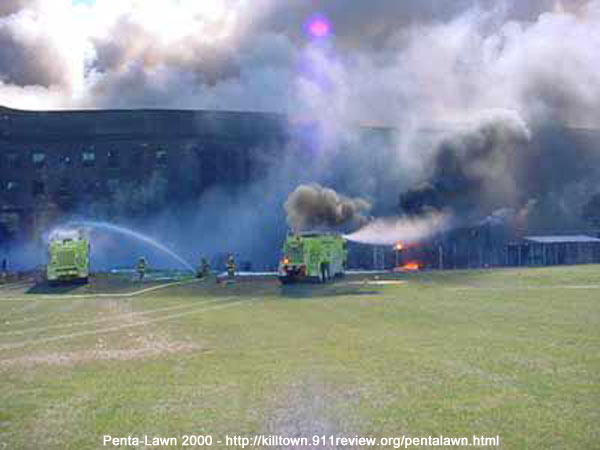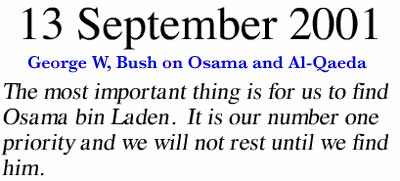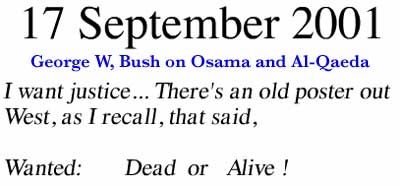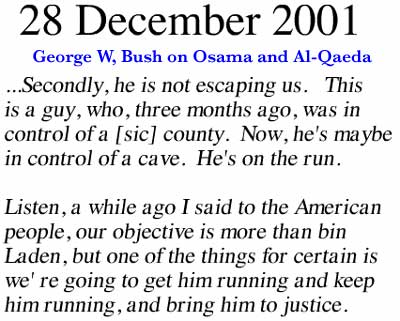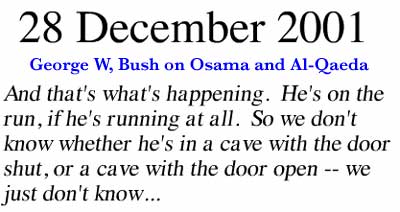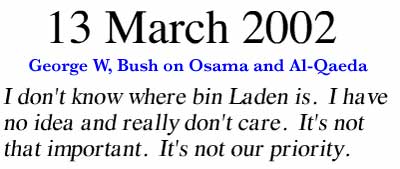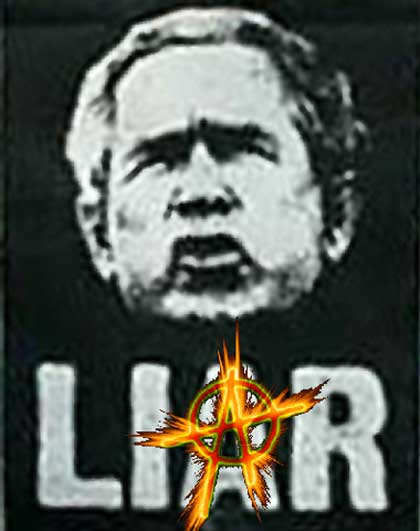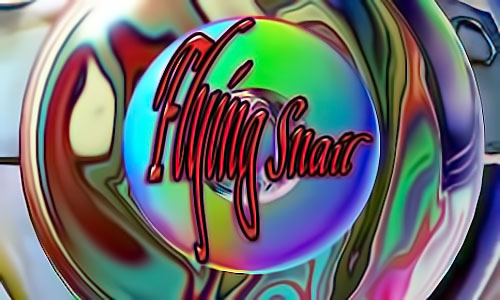
Tell-A-Vision = Why Not Try Love Again?
Mike Wilhelm & Hired Guns at the Lake County Fair
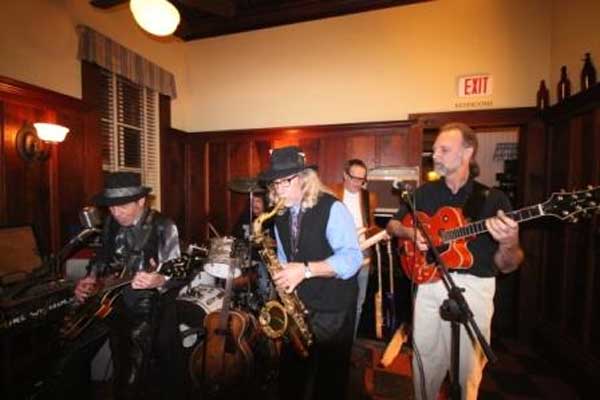
Mike Wilhelm, , Scott Slagle, Jim Leonardis, Jamie Webber and Randy Hare @ the Blue Wing Photo: Jim Warren
Main Stage: Saturday, September 3, 2011 at 12:00, 2:00 & 4:00 pm
August 30, 2011
FOR IMMEDIATE RELEASE:
Mike Wilhelm & Hired Guns at the Fair Saturday
By Alex Johns
LAKEPORT - International recording artist and Lake County resident Mike Wilhelm will take the stage at the Lake County Fair on Saturday, September 3 with his five-piece band Hired Guns. Performance times are 12:00, 2:00 and 4:00 pm.
Asked to estimate the number of dates he has played the 69 year old fingerstyle guitarist replied with a chuckle, "I lost count at around 3500 thirty or forty years ago."
Wilhelm was more forthcoming when asked about well-known names he has played with. "I've shared stages and/or jammed with Brownie McGhee & Sonny Terry, the Chambers Brothers, Sons of Champlin, Buddy Guy, The Police, Rockpile, Paul Butterfield, Mike Bloomfield, Elvin Bishop, Danny Kalb, Steppenwolf, Janis Joplin & Big Brother, Janis & Full Tilt Boogie, Jefferson Airplane, Quicksilver Messenger Service, Greg Elmore, John Cipollina, Pete Sears, Mark Naftalin, John Mayall, Nicky Hopkins, Grateful Dead, Country Joe & the Fish, Barry Melton, Nick Gravenites, Troyce Key & JJ Malone, Monica Dupont, Mitch Rider, John Kay, 13th Floor Elevators, the Explosives, the Plimsouls, Peter Case, Iggy Pop, Velvet Underground, Colin Linden, Greg Douglas, Erik Frandsen, Steve Mann, Glen Campbell, Dick Rosmini, Fred Gerlach, Ry Cooder, Taj Majal, John Hammond, Dave Edmunds, Nick Lowe, Billy Bremner, Romel Amado, dr kyOn, Yotchan...those last three in Japan, two are major stars there. Some of those names are not household words but they are all highly talented musicians, well known amongst their peers. There are so many that I can't bring them all to mind at the moment."
He went on with obvious pride, "Interesting thing, I did an internet search a couple of weeks ago to find out about the availability of my past recordings. I found that every studio recording I've ever been on going back to 1965 is still in print on CDs. I don't think there are many artists who can make that claim. My fan base is worldwide. While I may not have had any big hit records my place as an international recording artist is assured." He says that his royalty statements for the Charlatans, the Flamin' Groovies and solo albums show sales in Albania, Argentina, Belgium, Canada, England, Finland, France, Holland, Indonesia, Ireland, Italy, Japan, Mexico, Northern Ireland, Norway, Russia, Singapore, Spain, Sweden and the United States.
He is effusively enthusiastic about his current band which now includes bassist James Webber. "Jamie toured for years with Lonnie Mack up until Lonnie's retirement. I didn't pick him as a bass player, he picked me. He commutes all the way from Ft. Bragg to rehearse with me and my band which I really appreciate. My former bass man Randy Hare is now on guitar and that is a good thing 'cause he has really got the guitar chops goin' on. He can more than hold his own in any bag be it blues, rock, jazz, fusion...you name it. I am honored to have him in my band. Slammin' Scott Slagle is the equal of any drummer I've played with and I am blessed to have played with some greats. He and Jamie are always in the pocket and his energy, enthusiasm and joy are infectious and manifest at every rehearsal and most especially at the gig. Jim Leonardis, whom I like to call 'Jimmy the Lion', is a very talented jazz tenor sax player who chose to settle in Lake County and I am delighted that he also chooses to play with me.
"My wife and I settled in Lake County first and foremost to be near our grandchildren and secondly because the clean air is better for my lung problems. My wife has been coming up to the lake since the '40s when her family vacationed here. It was a joy to find so many seasoned professional musicians here but I was disappointed to find that they're not really well supported by the locals despite all the lip service to 'buy local'. Most have to go out of the county to find decent paying gigs though I do commend Richard Persons of the Lake County Fair for his continuing support of Lake County musicians."
Asked why he doesn't tour more often, he answered, "My health prevents me from touring extensively and, although I do get out there now and then, I have been forced to turn down some major gigs." Lucky Lake County residents can hear him at their own county fair.
More information is available at lakecountyfair.com and mike-wilhelm.com.
Best regards, Alexandria Johns
David writes: This is my latest painting:"Ménage à trois"

For more info about this piece (or any of my other work) please visit my blog, http://normal.bz/ - David Normal
Remembering Profits-Not-People Criminal PG&E
San Bruno Murders September 9, 2010 @ 6:38pm
Scars Remain Year After Deadly [PG&E] Gas Explosion
CPUC Goes Down On PG&E?
One year after San Bruno blast: When watchmen fall asleep at the switch
By: Katie Worth, kworth@sfexaminer.com, 09/06/11 4:00 AM, Examiner Staff Writer, Article Source
In 1911 the Railroad Commission of California was established because an outraged public demanded there be some regulation of the powerful rail barons that had repeatedly proved they were incapable of regulating themselves.
A century later, that agency — redubbed the California Public Utilities Commission — would come under fire from a once-again outraged public for not adequately regulating a different powerful industry. This time the results were deadly: Eight people died on Sept. 9, 2010, when a PG&E gas transmission line exploded and reduced a San Bruno neighborhood to ash.
Commission leaders initially defended the agency’s oversight of PG&E, but after federal investigators and an independent panel created by the commission both condemned the regulator for a host of inadequacies, even the agency’s leadership has come to agree it bears some responsibility.
The CPUC could have helped avert this disaster, concluded the National Transportation Safety Board, which just wrapped up a yearlong investigation into the pipeline blast. An adequate regulator would have known that PG&E lacked documentation about its pipe system, that its inspection programs were feeble, and that it had an inadequate emergency response plan, NTSB investigators testified in a hearing last week.
Worse, even when they did realize PG&E was violating regulations, the commission simply took industry leaders at their word when they promised to fix the problems, rarely imposing fines or enforcing major changes.
NTSB Chairwoman Deborah Hersman said PG&E “exploited weaknesses in a lax system of oversight” and that regulators placed “blind trust in an operator that doesn’t deserve that trust.”
Earlier this year, the independent panel formed by the CPUC to investigate the San Bruno accident concluded that the state regulatory agency hadn’t been doing its job. The panel’s report said that though well-meaning, the commission’s staff was plagued by a culture satisfied with making sure PG&E was in compliance with regulations — filing paperwork, meeting deadlines, and “checking off boxes.” Meanwhile, the agency’s true mandate to ensure public safety had been obscured. Even when the staff auditors and inspectors did find problems, as they did in an audit months before the San Bruno blast, those concerns were given such low priority that the staff failed to bring them to the full commission for months, the independent panel found. Often, when concerns were brought to the commission, nothing was done and no fines were imposed.
Among other recommendations, the NTSB has urged Gov. Jerry Brown to authorize CPUC safety staff to directly impose fines on the industry, rather than waiting on the full commission to impose penalties.
This host of regulatory failures could result in at least one lawsuit against the agencies overseeing the energy industry. San Francisco City Attorney Dennis Herrera has threatened to sue the CPUC and its federal counterpart, the Pipeline and Hazardous Materials Safety Administration, for failing to enforce gas pipeline safety standards.
Because major gas transmission lines run through San Francisco, these regulatory failures placed the people who live and work in The City at risk, Herrera argues.
“It has become increasingly obvious that blame must be shared by regulators who were either asleep at the switch or too cozy with the industry they’re supposed to regulate,” Herrera said in a written statement.
CPUC Executive Director Paul Clanon acknowledged his agency has “some responsibility to learn the lessons of San Bruno.”
“Eight people died — nobody at the PUC thinks that we are immune from some responsibility for that,” he said.
And it has already beefed up its oversight, by doubling the number of pipeline safety inspectors it had a year ago, and creating a new unit whose sole responsibility is to ask hard questions about safety.
Rep. Jackie Speier, D-San Mateo, noted that historically the CPUC conducted “desk audits,” where they rarely conducted site visits or dug more deeply into safety issues than necessary. She said auditors once “were easily persuaded by the utility to cut corners,” but that has now drastically changed.
And the makeup of the commission itself has changed, she said. Three of the five members on the board last year have since been replaced by appointments from Gov. Jerry Brown, bringing a more consumer-oriented bent to the board.
Among the new commissioners is Mike Florio, who spent much of his career fighting for consumers as the general counsel of advocacy group The Utility Reform Network. He said the agency must accept “a fair share of the blame” for San Bruno.
“It’s not that people were slacking off, but I think they weren’t asking the right questions, or asking the hard questions,” he said. “I think it’s in the process of being transformed. I think the whole situation really shook people here. All of us had become a little bit complacent.”
Disaster’s regulatory aftermath
San Bruno has already inspired a host of regulatory changes:
Every state pipeline operator must test or replace all pipelines that they lack records of testing before.
State operators can no longer solely use the cheap but lax “direct assessment” method to test pipes.
Pipeline operators must immediately call 911 when a possible rupture is detected.
Pipeline operators nationwide must proactively adapt their management strategies to avoid the circumstances of the San Bruno explosion.
Pipeline operators nationwide must notify first responders about the pipelines that run through their regions.
Outnumbered
9: Number of CPUC safety inspectors before blast
11,000: Average miles of pipeline per safety inspector before blast
18: Number of safety inspectors now
5,500: Average miles of pipeline per safety inspector now
Source: California Public Utilities Commission
Industry and regulators share messy family tree
Ask Paul Clanon whether his agency deserves the reputation of being too cozy with the industry it regulates, and you can feel his temperature rising.
“I think it’s completely off-base. It’s completely wrong in every way,” said the executive director of the California Public Utilities Commission.
But those people don’t seem to be going away. For the past year, the regulator has been under the microscope after a San Bruno neighborhood was maimed by an exploding PG&E natural gas pipeline. Those looking through that microscope — media, residents and lawmakers — have continued to question whether the regulator was complicit in the tragedy because it was too trusting and permissive with the industry it was tasked to put limits on.
Clanon’s outright dismissal of these concerns did not sit well with Assemblyman Jerry Hill, D-San Mateo.
“If he believes that then it’s time for him to go, because he’s living in a dream world,” Hill said.
Hill was among those who have questioned whether the commission and its staff are too enmeshed in the industries it regulates. He has repeatedly asked the commission about its staff general counsel, Frank Lindh, who worked for 16 years as an attorney for PG&E. Lindh is now participating in an investigation into PG&E, and Hill has asked whether there may be a conflict of interest.
Lindh has many defenders, even among consumer advocates who faced him when he worked for PG&E.
Sam Kang, general counsel of consumer advocate Greenlining Institute, described Lindh as a “great resource” for the advocates of the underserved who is “extremely well-respected by the industry, within the PUC and by consumer advocates.”
But as The San Francisco Examiner reported last month, Lindh is hardly the only person who has traveled between the industry and its regulator: the last executive director now is an energy consultant. The current commission president is a former utility executive. A former commissioner now is the executive of another utility. One Arnold Schwarzenegger-appointed director of government relations was an industry lobbyist before taking the position and went directly back into lobbying afterward.
Judy Nadler, a government ethicist at Santa Clara University, called such interconnections a “family tree syndrome — put everybody up there and you could link them all, one way or the other.”
She said this can be particularly problematic for an agency like the Public Utilities Commission, which runs under the public radar until something like the San Bruno tragedy occurs.
Revolving-door regulation?
As The San Francisco Examiner reported last month, critics have accused the California Public Utilities Commission of being “too cozy” with the energy industry it regulates. Here are a handful of leaders who have leadership positions from both the commission and the industry on their résumés.
FRANK LINDH
Worked as an attorney for PG&E for 16 years before being named general counsel of the CPUC in 2008.
MICHAEL PEEVEY
Has served as president of CPUC since 2002. Earlier in his career, he was president of energy company NewEnergy Inc., and prior to that led the utility Southern California Edison.
DELANEY HUNTER
Worked as energy lobbyist before being CPUC’s director of governmental affairs in 2005. Left commission in 2008 to return to energy lobbying.
STEVE LARSON
Served as CPUC executive director from 2005 to 2007 and was director of its energy division for eight years before that. Left to become executive for a natural gas company.
JESSIE KNIGHT JR.
Knight was appointed in 1993 to the CPUC, where he served until 1999. Years later he would go on to become the CEO and chairman of San Diego Gas & Electric.
PUC, PG&E both failed
The Monterey County Herald, Posted: 09/05/2011 01:28:36 AM PDT, Updated: 09/05/2011 01:28:36 AM PDT, Article Source
It was not a question of 'if' this pipeline would burst," said Deborah Hersman. "It was a question of 'when.'"
With those words, Hersman, the chairwoman of the National Transportation Safety Board, summarized the myriad failings by Pacific Gas & Electric Co. prior to a natural gas explosion a year ago that flattened a San Francisco Bay Area neighborhood, killing eight.
The board's report says the path to disaster began in 1956 when PG&E used substandard steel pipe for the high-pressure line beneath a San Bruno neighborhood. The board also cited shoddy welding and said inadequate inspections, slipshod recordkeeping and a failure to learn from past mistakes, including a fatal pipeline explosion in Sacramento County two years earlier, allowed the danger to go undetected.
Moreover, investigators said, PG&E's failure to install automatic shut-off valves and shortcomings in its emergency response plan resulted in confusion for firefighters and, ultimately, greater damage when the pipeline burst, incinerating 38 homes.
Taken together, the board's findings are a harsh indictment of one of the nation's largest utility companies. NTSB members also criticized state and federal regulators for putting "blind trust" in PG&E when they were supposed to be looking out for the public.
"This represents a failure of the entire system — a system of checks and balances that should have prevented this disaster," said Robert Sumwalt, an NTSB member. "The seam weld may have been the technical reason, but this was an organizational accident."
PG&E officials say they've learned their lesson. A few days before the NTSB adopted its scathing report, they promised a $2.2 billion overhaul of its 5,700-mile gas pipeline system, including enhanced testing for leaks, replacement of aging pipes and installation of the automatic shut-off valves that weren't available in San Bruno.
Did anyone doubt that better maintenance, new monitoring systems and other improvements would follow the San Bruno explosion? What's galling is that PG&E expects its ratepayers to foot the bill, emphasizing the relatively small cost — about $2 a month on the average consumer's bill.
If enhancing safety is such a bargain, why did PG&E wait for a catastrophe?
The state Public Utilities Commission should require PG&E shareholders to share in the cost of ensuring that its pipelines — and, therefore, its customers — are safe. Better yet, PG&E should take that step itself. It would say more than any of its apologies.
To address what the NTSB described as a "litany of failures," Congress and the state Legislature also need to act. It may be politically popular to decry rampant government regulation, but this is a case where more oversight was needed.
State and federal rules exempting the oldest pipelines — the ones most susceptible to failure — from leak-detection tests ought to be repealed. Automatic shut-off valves must be mandatory. And Gov. Jerry Brown should follow through on an NTSB recommendation to examine the PUC's ability to effectively enforce pipeline safety rules. - Santa Rosa, Press Democrat editorial
WATCH THIS VIDEO
[Criminal] PG&E Blast, Fire, and Cover-up: San Bruno Residents Speak Out "Profits Before People"
PG&E Dodges Blame in San Bruno Pipeline Explosion Lawsuits
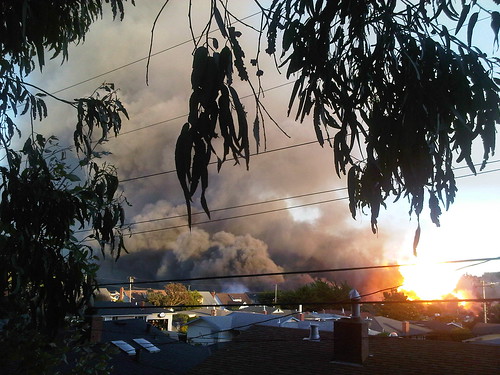
Photo credit: smi23le
After flubbing their initial response to last September's massive San Bruno pipeline explosion, utility Pacific Gas & Electric seemed to take responsibility for the accident, and even bought full-page ads in area newspapers proclaiming "We Apologize." But in court filings this week, PG&E has backtracked, denying any blame for the deadly pipeline explosion and suggesting that other parties were at least partially responsible in order to dodge millions of dollars in damages from more than 100 lawsuits.
PG&E blamed third parties and even the blast victims themselves for contributing to last September's pipeline explosion, which destroyed 38 homes, killed 8, and injured many more. The gas and electric company wrote in court filings that these victims "may have been legally responsible under a doctrine of comparative negligence (or) contributory negligence," but did not indicate specific ways they may have been negligent. San Bruno City Manager Connie Jackson called their assertions "completely surprising…It's unfortunate that they have thrown everything plus the kitchen sink in this, to cover their legal strategy."
PG&E claims aside, let's look at the evidence that has surfaced over the past 9 months thanks to the work of Bay Area reporters and safety advocates.
- In 2004, the national agency that regulates gas pipelines reported that pipeline degradation can occur with little obvious damage and required all major gas companies to conduct "risk-based assessments." After the accident, the Wall Street Journal reported that "none of the special measures was taken in the case of the San Bruno pipeline that exploded."
- Between 2003 and 2010, PG&E increased pressure on gas pipelines in San Bruno to dangerous levels more than a dozen times, according to the San Francisco Chronicle. The line was pushed to the federal limit of 400 pounds per square inch in December 2003 and again in 2008. Safety advocates say the 10 other pipelines that underwent similar tests could be vulnerable to future explosions.
- The National Transportation Safey Board has repeatedly criticized PG&E for serious "record-keeping problems" which they say could lead to "potentially unsafe" pressure settings and even future pipeline explosions. In one example, PG&E initially claimed that the San Bruno pipeline in question had no ruptured seams, which was later proven false.
It's difficult to tell whether PG&E will maintain this obstinate throughout the legal process. For now, PG&E spokeswoman Brittany Chord has called the filing "a standard part of the legal process" and said that PG&E will "continue to move forward and work to resolve the claims of all parties as quickly as possible."
UPDATE: PG&E is now claiming that it did not blame victims for last September's pipeline explosion. "We want it to be crystal clear that no one at PG&E would suggest that the plaintiffs or residents of San Bruno impacted by this accident are somehow at fault," the company said in a statement. - Source
TIME FOR A CORPORATE DEATH PENALTY!
No Corporate PG&E Executives
Charged With Murder?
PG&E San Bruno Explosion Lawsuit Defense Includes Blaming Victims
http://sanfrancisco.cbslocal.com/2011/07/11/pge-seeks-jury-trial-for-san-bruno-blast-lawsuits/
SAN BRUNO VICTIMS OUTRAGED BY PG&E COURT FILING
http://turn.org/article.php?id=1724
[PG&E] Pipeline Records Probably "Trashed"
http://www.nbcbayarea.com/news/local/Former-PGE-Manager-Pipeline-Records-Probably-Trashed-126037773.html
California PUC's safety head leaves job
http://www.mercurynews.com/breaking-news/ci_18531984?nclick_check=1
55 more people sue PG&E over San Bruno blast
http://www.mercurynews.com/san-mateo-county/ci_18477877
Newly Released NTSB Records Confirm [PG&E] Piecemeal Pipe
http://sanbruno.patch.com/articles/newly-released-ntsb-records-confirm-piecemealed-pipe
Smart Meters:
PG&E's Evil Public Payback For Voting Down Prop. 16?
PG&E Smart Meters via prez @ usa-exile
World Health Organization has classified SmartMeter
Radiation as "possibly carcinogenic to humans."
***
Condoleezza Rice 'was first Republican Bush
official
to approve torture of terror suspects'
How US firms profited from torture flights
Court documents illustrate how US contracted out secret rendition transportation to a network of private companies
Ian Cobain and Ben Quinn, guardian.co.uk, Wednesday 31 August 2011 21.20 BST, Article history, Article Source

Court documents show how a network of US private companies profited from rendition operations. Photograph: Alamy
The scale of the CIA's rendition programme has been laid bare in court documents that illustrate in minute detail how the US contracted out the secret transportation of suspects to a network of private American companies.
The manner in which American firms flew terrorism suspects to locations around the world, where they were often tortured, has emerged after one of the companies sued another in a dispute over fees. As the 10th anniversary of 9/11 approaches, the mass of invoices, receipts, contracts and email correspondence – submitted as evidence to a court in upstate New York – provides a unique glimpse into a world in which the "war on terror" became just another charter opportunity for American businesses.
As a result of the case, the identities of some of the corporations involved in the rendition programme have been disclosed for the first time, along with the names of some of the executives who knew the purpose of the flights.
One unintended consequence may be that some of those corporations and individuals are now at risk of being sued in proceedings brought on behalf of the al-Qaida and Taliban suspects who were the victims of the programme.
The New York case concerns Sportsflight, an aircraft broker, and Richmor, an aircraft operator. Sportsflight entered into an arrangement to make a Gulfstream IV executive jet available at $4,900 an hour rather than the market rate of $5,450. A crew was available to fly at 12 hours' notice. The government wanted "the cheapest aircraft to fulfil a mission", Sportsflight's owner, Don Moss, told the court. But it was the early days of the rendition programme, and business was booming: the court heard that Sportsflight told Richmor: "The client says we're going to be very, very busy."
Invoices submitted to the court as evidence tally with flights suspected of ferrying around individuals who were captured and delivered into the CIA's network of secret jails around the world. Some of the invoices present in stark detail the expense claims that crew members were submitting on their secret journeys, down to £3 biscuits and £30 bottles of wine.
One Gulfstream jet has been identified as the aircraft that rendered an Egyptian cleric known as Abu Omar after CIA agents kidnapped him in broad daylight in Milan in February 2003 and took him to Cairo, where he says he was tortured.
Another invoice, for $301,113 relating to a series of flights over eight days that took the Gulfstream jet on an odyssey through Alaska, Japan, Thailand, Afghanistan and Sri Lanka, tallies with the rendition of Encep Nuraman, the leader of the Indonesian terrorist organisation Jemaah Islamiyah, better known as Hambali.
Other invoices follow flights that appear to have been involved in the rendition of Khalid Sheikh Mohammed, the man said to have masterminded the 9/11 attacks. After being captured in 2003, Mohammed disappeared into the CIA's secret prisons, where he was waterboarded 183 times in just one month, according to a US justice department memo. The invoices also show the aircraft flying in and out of Bucharest, where one of the CIA's secret prisons is now known to have been located. On one occasion, the court heard, the jet flew direct from a European airport to Guantánamo. The court heard that in October 2004 the aircraft's tail number was changed, to N227SV, after the US government discovered that its movements were being tracked. The following March the aircraft was publicly linked to the Abu Omar rendition.
The documents were discovered by staff at the legal charity Reprieve. Its legal director, Cori Crider, said: "These documents reveal how the CIA's secret network of torture sites was able to operate unchecked for so many years. They also reveal what a farce it was that the CIA managed to get the prisoners' torture claims kicked out as secret, while all of the details of its sinister business were hiding in plain sight."
Richmor was providing the aircraft for DynCorp, a private military company, which was acting on behalf of the CIA. The bills for the operation passed through Sportsflight and a second aircraft broker, Capital Aviation. Portions of DynCorp were sold by its parent company in 2005. The entity that was sold became known as DynCorp International.
The aircraft's ultimate owner was Phillip Morse, an American businessman with substantial sporting interests who was subsequently appointed vice-chairman of Fenway Sports Group, the company that owns Liverpool FC. In between rendition flights the aircraft was used to fly the Boston Red Sox baseball team.
The court documents make only passing reference to the human cargo being transported. Enough details of the rendition programme generally have now been disclosed to know that men on these flights were usually sedated through anal suppositories before being dressed in nappies and orange boiler suits, then hooded and muffled and trussed up in the back of the aircraft. The precise conditions in which suspects were transported on Richmor flights are not known.
Richmor's president, Mahlon Richards, told the court that the aircraft carried "government personnel and their invitees" (pdf). "Invitees?" queried the judge, Paul Czajka. "Invitees," confirmed Richards. They were being flown across the world because the US government believed them to be "bad guys", he said. Richmor performed well, Richards added. "We were complimented all the time." "By the invitees?" asked the judge. "Not the invitees, the government."
BEN-VENISTE: Isn't it a fact, Dr. Rice, that the August 6 [2001] PDB warned against possible attacks in this country? And I ask you whether you recall the title of that PDB?
RICE: I believe the title was,
"Bin Laden Determined to
Attack
Inside the United States." [using planes]
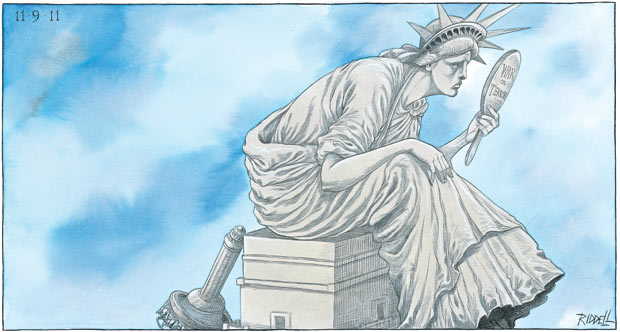
Ten years on, America reflects Chris Riddell on America's war on terror
MonkeyRedux: Wishful thinking.
There's been precious little reflection in the US in the last ten years. Quite the opposite, sadly.
I cried on 9/11. It upset me deeply.
But I have cried often since for all the nameless dead of Iraq and Afghanistan.
I've never thought that American lives were more valuable than Iraqi lives, or Afghani lives, or indeed Chilean lives rubbed out on 9/11/73.
The great enduring tragedy of 9/11 is that it has been hijacked by the corporate machine to kill hundreds of thousands to profit a tiny few.
So let's never forget that Dick Cheney and Donald Rumsfeld outsourced the Iraq War to Halliburton.
And let's not forget that Cheney and Rumsfeld were major shareholders in Halliburton.
And let us never forget that Halliburton switched its corporate and tax base to Dubai while US troops and Iraqi people were dying.
Dixie Chicks - Not Ready To Make Nice
Free Bees - 9/11's a Lie (Stayin' Alive) - via prez @ usa-exile
On September 11 Ask Yourself:
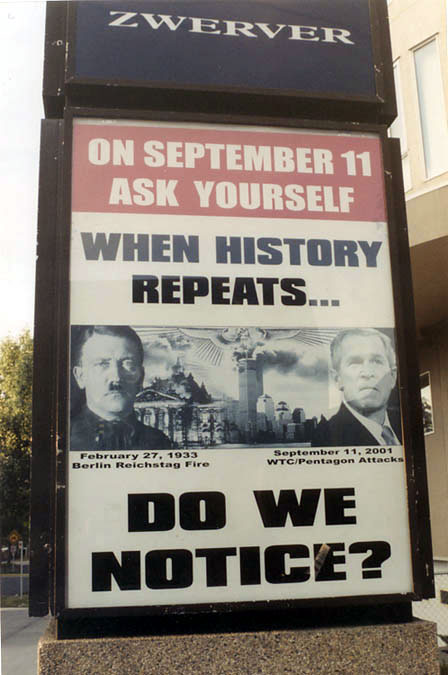
When History Repeats... Do We Notice?
America Remembers Again by Mark Fiore
Lies, Lies, Lies - BlackMustache.com
Condoleezza Rice's 9/11 Historical Statements or Lies? - They Knew by Balzac
I would move heaven and earth to protect my husb..errr.. President Bush!
A pressing issue of dinner-party etiquette is vexing Washington, according to a story now making the D.C. rounds: How should you react when your guest, in this case national-security adviser Condoleezza Rice, makes a poignant faux pas? At a recent dinner party hosted by New York Times D.C. bureau chief Philip Taubman and his wife, Times reporter Felicity Barringer, and attended by Arthur Sulzberger Jr., Maureen Dowd, Steven Weisman, and Elisabeth Bumiller, Rice was reportedly overheard saying, "As I was telling my husb--" and then stopping herself abruptly, before saying, "As I was telling President Bush."

The United States of oil
No administration has ever been more in bed with the energy industry -- but does that mean Big Oil is calling Bush's shots? First of two parts.
BY DAMIEN CAVE, Article Source
The Bush administration's ties to oil and gas are as deep as an offshore well. President George W. Bush's family has been running oil companies since 1950. Vice President Dick Cheney spent the late '90s as CEO of Halliburton, the world's largest oil services company. National Security Advisor Condoleezza Rice sat on the board of Chevron, which graced a tanker with her name. Commerce Secretary Donald Evans was the CEO of Tom Brown Inc. -- a natural gas company with fields in Texas, Colorado and Wyoming -- for more than a decade.
The links don't end with personnel. The bin Laden family and other members of Saudi Arabia's oil-wealthy elite have contributed mightily to several Bush family ventures, even as the American energy industry helped put Bush in office. Of the top 10 lifetime contributors to George W.'s war chests, six either come from the oil business or have ties to it, according the Center for Public Integrity.
"There's no denying that this is an oil administration," says Peter Eisner, managing director of the nonprofit, nonpartisan watchdog group that conducted the study of Bush's campaign finances. "You can't talk about the career of any George Bush -- father or son -- without talking about oil."
But talking is one thing; determining exactly how the ties to the oil industry affect domestic and foreign policy is another. How much influence does the oil industry have? Is the U.S. bombing Afghanistan in part because -- as antiwar critics have claimed -- the industry wants to clear a path for oil and gas pipelines? Will the Bush administration steadfastly avoid confrontation with Saudi Arabia -- home of 15 of the 19 suspected hijackers -- because it doesn't want to upset ExxonMobil and the other oil companies with a deep Saudi stake? Or, even more intriguingly, could the close ties between Bush and the Saudis lead to increased U.S. pressure on Israel to create a peace settlement?
Or is this too simplistic? Since at least World War II, the oil industry has often been forced by the U.S. government to serve foreign policy objectives, rather than the other way around. Presidents have generally accepted oil's economic significance, its role as the grease that makes capitalism go. But even the most conservative administrations have regularly emphasized geopolitical objectives -- Soviet containment, for example -- at the expense of oil industry interests. Aspects of Bush's energy plan suggest that even this administration will not break the give-and-take pattern.
The problem, however, is that this pattern, the so-called "cheap oil strategy" looks more and more like a failure. Foreign oil dependence has risen over the past decade while now -- with anti-American sentiment growing in the Arab world -- foreign oil supplies are looking increasingly insecure. More than ever, some kind of national policy pushing both conservation and the development of renewable energy resources seems eminently prudent, if not necessary.
And that's where the current makeup of the Bush administration becomes crucial -- not because Bush-Cheney and company plan to invade Iraq to make it safe for ExxonMobil, (although that's not totally beyond the bounds of possibility) but because these are the last men and women in the world to expect radical change from on questions related to energy. Their friends, finances, and worldviews are all oil-drenched.
George W.'s ties to oil don't prove that the industry decides our every foreign policy move. But they do just about guarantee, for all practical purposes, that nothing significant will change in American energy policy. With Bush-Cheney in power, oil addiction is here to stay.
The fusion of oil and politics is a Bush family tradition. For generations, the Bushes and their friends have been shuttling back and forth between energy industry boardrooms and Washington's hallowed halls.
Bush's grandfather, Prescott Bush, initiated the pattern. Shortly before winning a Connecticut Senate seat in 1952 he helped his son George raise $350,000 to start what would become Zapata Petroleum.
Sen. Bush also regularly looked out for the oil industry and his son's interests while in Washington. His biggest single favor, according to Herbert Parmet's book "George Bush: The Life of a Lone Star Yankee," came a year into his first Senate term, when he opposed legislation that would have federalized offshore resources -- including oil -- to raise money for education. In the name of states' rights and free enterprise, the bill's defeat helped both the oil companies and gave Zapata just what it needed to expand. In fact, soon after the legislation failed, Zapata moved into offshore drilling -- eventually one of Zapata's most lucrative ventures
George Bush made millions during the '50s and '60s Texas oil boom, and he also made many friends, most notably James Baker, who became Bush's company lawyer in 1963 after Zapata merged with Penn to become Pennzoil.
Bush later brought his friends to Washington, first as a representative in the House, then as head of the Republican National Committee and finally as vice president and president. He didn't stock his administration as full of oilmen and women as his son has, but like Prescott Bush, he didn't mind doing the industry's bidding either. His most public act for oil came in 1981. While serving as Ronald Reagan's vice president, he departed from the White House's official stance and visited Saudi Arabia to plead for an end to sliding prices. Bush argued that he was simply trying to protect American security interests by protecting domestic producers, who have higher costs than their Persian Gulf counterparts. But higher prices had another benefit: by protecting domestic oil jobs, they helped shore up support in Texas for what would eventually become his successful 1988 presidential campaign.
Higher prices also directly helped Bush's son, George W. Bush. George W.'s oil career started in 1978 -- 12 years after his father first entered Congress -- when several of his father's friends invested in his firm, Arbusto ("Bush" in Spanish). Unlike his father, George W. spent much of his oil career in the red. As Joe Conason pointed out in Harper's last year before the election, the company's original investors and others bailed out his firm at least three times. But after a final act of corporate CPR -- a merger with Harken Energy in 1986 -- Bush's connections to power really paid off. Two years after the merger, Abdullah Taha Bakhsh, a former director of Saudi Arabia's income tax department, purchased an 11 percent stake in Harken through his company Traco International. That same year, Harken won a contract for oil-drilling in Bahrain.
"Harken had no international experience at the time," says Eisner at the Center for Public Integrity, which published a detailed account of Bush's rise to power titled "The Buying of the President: 2000." "It was their first out of country contract."
Press reports at the time questioned Bahrain's motivations. Even the normally reserved Wall Street Journal reported in 1991 that the contract "raises the question of ... an effort to cozy up to a presidential son."
The Bush family countered that the contract was well deserved. Regardless, the deal in the Persian Gulf gave Bush a direct tie to the Saudi elite and set Bush on a suddenly successful path.
"It's not just the matter of a single contract," Eisner says. "It also has to do with converting Harken into a player that was then converted into a stake in the Texas Rangers and a run for governor. It's not incidental. The Bahrain deal is central to Bush's life."
Some experts suggest that it's not necessarily a bad thing to have a presidential family so steeped in oil knowledge, given the importance of oil to both national security and the domestic economy. But Bush has shown a pervasive willingness to let oil interests define energy and environmental policy. After accepting millions from the industry during his run for governor, he signed into law tax breaks for state energy producers, and in 1997, he gave them a hand in writing their own rules. Upon hearing that Texas' state environmental agency planned to end an exemption that allowed power plants built before 1971 to avoid complying with state pollution laws, Bush tapped two people to come up with an alternative plan: Vic Beghini, an executive with Marathon Oil Inc. and Ansel Condray, an executive with Mobil.
The plan they came up with initiated a voluntary pollution reduction program that didn't punish companies for noncompliance and thus essentially failed. A study by the Environmental Defense Fund published six months after Bush announced the program revealed that only three of the 26 companies had actually cut their emissions. Two years later, under increasing public pressure, Bush signed a bill forcing power plants to cut their emissions in half by 2003 -- but the essential exemption, as the industry wanted, still stands.
The politicos surrounding Bush also have enjoyed warm government/oil-industry connections. While Bush used his elected position to help friends in his former industry, Cheney employed past government connections to improve his own bottom line.
Iraq provides the most dramatic example. Cheney, intentionally or inadvertently, went against his own edicts in order to pad his company's profits. He told Sam Donaldson in August 2000 that, as the head of Halliburton, "I had a firm policy that I wouldn't do anything in Iraq, even arrangements that were supposedly legal." And yet, as the Financial Times eventually proved, Cheney oversaw $23.8 million in sales to Iraq in 1998 and 1999. Cheney, who collected a $36 million salary before becoming vice president, essentially profited from the destruction of Iraq that he oversaw as secretary of defense during the Gulf War. And while the oil-rig and equipment sales were legal -- a 1998 U.N. resolution gave Iraq the right to rebuild its oil industry -- Cheney's firm sold through European subsidiaries "to avoid straining relations with Washington and jeopardizing their ties with President Saddam Hussein's government," according to a November 2000 Financial Times report.
Cheney also helped Halliburton obtain a windfall of U.S. government loans. He secured $1.5 billion in taxpayer-backed financing for Halliburton -- a massive increase over the $100 million loan it received during the five-year period before Cheney took over. And while Cheney has claimed that Halliburton's rise to power had nothing to do with his political stature, State Department documents obtained by the Los Angeles Times suggest that U.S. officials assisted Halliburton both in Asia and Africa. Even the domestic defense-contracting arm of Halliburton -- Brown & Root -- saw its fortune change drastically once Cheney took over. The company booked $1.2 billion in contracts between 1990 and 1995; with Cheney at the helm, contract awards spiked to $2.3 billion between 1995 and 2000.
Other Bush administration officials have also profited from past government experience and influence. Bush's father and his then Secretary of State James Baker -- the lawyer who fought for Bush during the Florida election fiasco -- work for the Carlyle Group, an investment firm that until recently collected investments from the bin Laden family and other members of the Saudi elite. Reagan's Secretary of State George Schultz sat on the board of Chevron before the arrival of Condoleezza Rice.
Rice joined the Chevron board in 1991, after serving for a year on Bush Sr.'s National Security Council. There, she earned a $35,000 annual retainer, $1,500 for every meeting she attended and stock options worth hundreds of thousands of dollars, according to SEC documents. She was reportedly hired for expertise in the former Soviet states, and long before U.S. planes started dropping bombs in nearby Afghanistan, she spent much of her time at Chevron working on prospective deals in the Caspian region. Chevron (with Mobil) already produces 70 percent of the oil coming out of the Tengiz oil field in Kazakhstan, according to Ahmed Rashid's book, "Taliban," and the company has been working hard to secure a pipeline that would allow more oil to be produced. In 1993, with Rice on the board, the company pulled together a pipeline project to carry oil to a Russian port on the Black Sea. Russian opposition eventually postponed the plan indefinitely but Chevron still holds a 45 percent stake in the project -- and given the present state of improved Russian-American relations, many suspect that project will eventually get off the ground.
The slowly improving relations between the U.S. and Iran could also help Chevron. When negotiations over pipelines from Tengiz broke down a few years ago, Chevron turned its focus toward the Islamic theocracy, asking the Clinton State Department for a "swapping" license. Approval would have allowed oil from Tengiz to be shipped across the Caspian to Iran while, in exchange, Chevron would be able to sell an equal amount of Iranian oil that would be shipped from the Persian Gulf. The proposal was never approved, but given Rice's ties, many have suspected that Chevron will soon play a larger role in American foreign policy, whether in Iran or the Caspian.
Critics of the Bush administration point out that a stabilized Caspian region could benefit Rice's friends at Chevron, and if she returns to the board, Rice herself. They also argue that maintaining dependence on Saudi oil could benefit Cheney's old firm and Bush's father, and ultimately, the president himself when an inheritance comes his way.
But there is no clear evidence, right now, of oil company desires affecting current U.S. foreign policy. If anything, the terrorist attacks have reduced the energy industry's influence. Before Sept. 11 Saudi Arabia was reportedly pushing the U.S. to pressure Israel into Palestine peace concessions and, according to a Newsweek story, Bush was beginning to comply. But after Sept. 11, the chance that the U.S. would accede to Saudi requests evaporated, given the numerous Saudi connections to the attacks.
In that sense, the trajectory of oil influence over foreign policy has continued upon its historical path. A review of the evidence suggests that over time, the oil industry has progressively lost power. But that still doesn't mean that the current administration is likely to do anything radical to alter U.S. dependence on foreign oil -- barring the unlikely event of Bush pulling a Nixon-visit-to-China shock, and using his oil ties to force a real commitment to renewable energy and conservation.
Maybe This Will Help You Understand What Republicans Did, with Democrat Support:
BBC (Before Bush Jr./Cheney) - 1999 - Oil = $17 per barrel
ABC (After Bush Jr./Cheney) - Sept. 2011 - Oil = $115 per barrel[War Criminal Says What? "Go massive, Sweep it all up. Things related and not."]
Penta-Lawn 2000 - Did the Gas Station 9/11 Pentagon Video Tape Get Misplaced ???"Some eyewitnesses believe the plane actually hit the ground at the base of the Pentagon first, and then skidded into the building." - CBS
"...it didn't appear to crash into the building; most of the energy was dissipated in hitting the ground, but I saw the nose break up, I saw the wings fly forward, and then the conflagration engulfed everything in flames...But I think the blessing here might have been that the airplane hit before it hit the building, it hit the ground, and a lot of energy might have gone that way. That's what it appeared like." - CNN
"What -- or who -- caused Flight 77 to hit ground first, diffusing most of its destructive energy before it slammed into the Pentagon?" - ESPN/MSN
"According to one witness, 'what looked like a 747' plowed into the south side of the Pentagon, possibly skipping through a heliport before it hit the building." - Stars and Stripes
Plans For Iraq Attack Began On 9/11
By Joel Roberts, Article Source
CBS) CBS News has learned that barely five hours after American Airlines Flight 77 plowed into the Pentagon, Defense Secretary Donald H. Rumsfeld was telling his aides to come up with plans for striking Iraq -- even though there was no evidence linking Saddam Hussein to the attacks.
That's according to notes taken by aides who were with Rumsfeld in the National Military Command Center on Sept. 11 – notes that show exactly where the road toward war with Iraq began, reports CBS News National Security Correspondent David Martin.
At 9:53 a.m., just 15 minutes after the hijacked plane had hit the Pentagon, and while Rumsfeld was still outside helping with the injured, the National Security Agency, which monitors communications worldwide, intercepted a phone call from one of Osama bin Laden's operatives in Afghanistan to a phone number in the former Soviet Republic of Georgia.
The caller said he had "heard good news" and that another target was still to come; an indication he knew another airliner, the one that eventually crashed in Pennsylvania, was at that very moment zeroing in on Washington.
It was 12:05 p.m. when the director of Central Intelligence told Rumsfeld about the intercepted conversation.
Rumsfeld felt it was "vague," that it "might not mean something," and that there was "no good basis for hanging hat." In other words, the evidence was not clear-cut enough to justify military action against bin Laden.
But later that afternoon, the CIA reported the passenger manifests for the hijacked airliners showed three of the hijackers were suspected al Qaeda operatives.
"One guy is associate of Cole bomber," the notes say, a reference to the October 2000 suicide boat attack on the USS Cole in Yemen, which had also been the work of bin Laden.
With the intelligence all pointing toward bin Laden, Rumsfeld ordered the military to begin working on strike plans. And at 2:40 p.m., the notes quote Rumsfeld as saying he wanted "best info fast. Judge whether good enough hit S.H." – meaning Saddam Hussein – "at same time. Not only UBL" – the initials used to identify Osama bin Laden.
Now, nearly one year later, there is still very little evidence Iraq was involved in the Sept. 11 attacks. But if these notes are accurate, that didn't matter to Rumsfeld.
"Go massive," the notes quote him as saying. "Sweep it all up. Things related and not."
Republican George W. Bush Jr.
Lied About Finding Osama
September 13, 2001
The most important thing is for us to find Osama bin Laden. It is our number one priority and we will not rest until we find him.
September 17, 2001
I want justice. There's an old poster out West, as I recall, that said, Wanted: Dead or Alive !
December 28, 2001
Secondly, he is not escaping us. This is a guy, who, three months ago, was in control of a [sic] county. Now, he's maybe in control of a cave. He's on the run. Listen, a while ago I said to the American people our objective is more than bin Laden, but one of the things for certain is we're going to get him running and keep him running, and bring him to justice.
December 28, 2001
And that's what's happening. He's on the run, if he's running at all. So we don't know whether he's in a cave with the door shut, or a cave with the door open -- we just don't know ...
March 13, 2002
I don't know where bin Laden is. I have no idea and really don't care. It's not that important. It's not our priority.
April 8, 2002
I am truly not that concerned about him.
Liars Recap:
September 13, 2001
The most important thing is for us to find Osama bin Laden.
It is our
number one priority and we will not rest until we find him.
April 8, 2002
I am truly not that concerned about him.
The Above Is In Flash Video Format: http://www.flyingsnail.com/Dahbud/BOQ.html
The BUSH & bin LADEN FAMILIES are FRIENDS
The Family Ties Between Bush and Bin Laden
by Christopher Bollyn, October 3, 2001, Article Source
The world now associates the Bin Laden name with Osama Bin Laden, the prime suspect be hind the terror atrocities of Sept. 11. As President George W. Bush leads an intense international manhunt for Osama, few Americans realize that Osama's eldest brother, Salem, was one of Bush's first business partners. The unexplained death of Salem, Osama Bin Laden's oldest brother, in 1988, brought to an abrupt end a long and intriguing relationship between President Bush and the head of the Bin Laden family fortune.
A photograph from 1971 has been printed in English papers showing Osama, age 14, and his brother Salem, age 19, enjoying a summer holiday at the Astoria Hotel in Falun, Sweden. Christina Akerblad, the hotel owner, told the Daily Mail, "They were beautiful boys, so elegantly dressed. Everybody loved them."
Osama embraced Islamic fundamentalism and is now the world's most wanted man. "Salem went on to become a business partner of the man who is leading the hunt for his brother," the Daily Mail's Peter Allen said. "In the 1970s, he and George W. Bush were founders of the Arbusto Energy oil company in Mr. Bush's home state of Texas." President Bush and the Bin Laden family have been connected through dubious business deals since 1977, when Salem, the head of the Bin Laden family business, one of the biggest construction companies in the world, invested in Bush's start-up oil company, Arbusto Energy, Inc.
James R. Bath, a friend and neighbor, was used to funnel money from Osama Bin Laden's brother, Salem Bin Laden, to set up George W. Bush in the oil business, according to the Wall Street Journal and other reputable sources. Through a tangled web of Saudi multi-millionaires, Texas oilmen, and the infamous Bank of Credit and Commerce International (BCCI), Bush was financially linked with the Bin Laden family until Salem met an untimely end in a freak flying accident near San Antonio in 1988. The infamous BCCI was shut down in 1991 with some $10 billion in losses.
In June 1977, George W. Bush formed his own oil drilling company, Arbusto Energy, in Midland, Texas. "Arbusto" actually means "shrub" in Spanish, but the Bush family interpreted it as "bush". Salem Bin Laden, a close friend of the Saudi King Fahd, had "invested heavily in Bush's first business venture," according to the Daily Mail (U.K.).
Arbusto later became Bush Exploration, when Bush's father became vice president. As the company neared financial collapse in September 1984, it was merged with Spectrum 7 Energy Corp. in an effort to stay afloat. The 50 investors who propped up the Bush company with $4.7 million were "mainly friends of my uncle" who "did pretty good" in Bush's words, although they lost most of the money they invested in the company. Jon Bush, George's uncle, raised money for Arbusto from political supporters of the Reagan-Bush administration.
"These were all the Bush's pals," family friend Russell Reynolds told the Dallas Morning News in 1998. "This is the A-Team." The limited partners of the "A-Team" contributed $4.67 million to various Bush funds through 1984 but got only $1.55 million back in profit distributions, and $3.9 million in tax write-offs.
William DeWitt and Mercer Reynolds, two staunch Reagan-Bush supporters, owned Spectrum 7. Despite his poor track record, the owners made Bush president of the company and gave him 13.6 percent of the parent company's stock.
SURPRISE DEAL
As the hard times continued, Spectrum merged with Harken Energy in 1986. In 1990, Harken received a contract from the government of Bahrain to drill for offshore oil although Harken Energy had never drilled a well overseas or anywhere in water. "Knowledgeable oil company sources believe that the Bahrain oil concession was indeed an oblique favor to the president of the United States but say that Saudi Arabia (home of Bin Laden) was behind the decision," according to The Outlaw Bank: A Wild Ride Into the Secret Heart of the BCCI, by Jonathan Beaty and S.C. Gwynne.
It raised oil-industry eyebrows when the Persian Gulf state announced it had chosen tiny Harken to explore an offshore site for gas and oil. Bahrain officials said they had no idea President Bush's son was associated with Harken, a claim oil-industry sources ridicule. The Bahrain deal was brokered in part by Arkansas investment banker David Edwards, one of Bill Clinton's closest friends. The Bahrain oil project resulted in two dry holes and Harken energy abandoned the project.
Two months before Iraq invaded Kuwait, on June 20, 1990, the younger Bush sold two-thirds of his Harken stock, 212,140 shares at $4 a share-for a total of $848,560. "That was $318,430 more than it was worth," Dr. Arthur F. Ide, author of George W. Bush: Portrait of a Compassionate Conservative, said. "George W. broke the law to do this since the transaction was an insider stock sale." Eight days later, Harken finished the second quarter with losses of $23 million and the stock went "into a nosedive" losing 75 percent of its value, finishing the year at a little over $1 a share.
"Like his father who made his fortune in the oil business with the money of others, George W. founded Arbusto with the financial backing of investors, including James R. Bath," said the late James Howard Hatfield, author of a "controversial biography," Fortunate Son: George W. Bush and the Making of an American President. Hatfield, 43, was found dead of an apparent prescription drug overdose in a hotel room in Springdale, Ark. on July 18, 2001. Police declined to investigate.
Bath became friends with George W. during their days together in the Texas Air National Guard. Bath "confided that he was an original investor in George Bush Jr.'s oil exploration company," according to The Outlaw Bank. Bath found investors for Arbusto and "made his fortune" by investing the money of two BCCI-connected Saudi sheiks, Khalid bin Mahfouz and Salem Bin Laden. Mahfouz was one of the richest men in the world and a controlling shareholder in BCCI.
Bill White, a former real estate business partner of Bath, said: "He had put up $50,000 to help George, Jr., get started in oil business" at a time when "Bath had no substantial money of his own." Bath received a 5 percent interest in two Arbusto-related limited partnerships controlled by Bush, although Bush told the Houston Post in 1990 that he had "never done any business" with Bath. However, Bush said Bath was "a lot of fun."
Bath told White that he was in the CIA and that "he had been recruited by George Bush himself in 1976 when Bush was director of the agency . . . he said Bush wanted him involved with the Arabs, and to get into the aviation business." White contends that the Saudis were using Bath and their huge financial resources to influence U.S. policy during the Reagan and Bush administrations, according to the Houston Chronicle of June 4, 1992. Such representation by Bath would require that he be registered as a foreign agent with the Department of Justice, but he was not.
Shortly after Bush's father was appointed director of the CIA, Salem Bin Laden appointed Bath as his business representative in Texas. According to the Houston Chronicle, Salem Bin Laden, heir to one of the largest building companies in the Middle East, signed a trust agreement appointing Bath as his Houston representative in 1976. In 1978, Bath purchased Houston Gulf Airport on behalf of Salem Bin Laden. When Bin Laden died in 1988, his interest in the airfield passed to bin Mahfouz. There was also a political aspect to Salem Bin Laden's financial activities, which played a role in U.S. operations in the Middle East and Central America during the 1980s, according to Public Broadcasting's Frontline report.
As head of Binladen Brothers Construction (now the Binladen Group), a company that later helped build U.S. airfields during Operation Desert Storm, Bin Laden was close to King Fahd of Saudi Arabia and "a good friend of the U.S. government," a San Antonio attorney, Wayne Fagan, who represented Salem Bin Laden from 1982 to 1988, told the San Antonio Express-News. When the family patriarch, Sheik Mohammed Bin Laden, died in 1968, he left an industrial and financial empire and a progeny of 54 sons and daughters, the fruit of a number of wives. In 1972, Salem Bin Laden, the oldest son, took over the estate as his father's successor, with the assistance of several brothers.
With over 40,000 employees, the Bin Laden Group is represented in the major cities of Saudi Arabia and the Arab capitals of Beirut, Cairo, Amman, and Dubai. The company builds highways, housing units, factories, hangars, and military bases, some of which are part of the U.S.-Saudi "Peace Shield" agreement. The story of the Bush involvement with Bin Laden and the BCCI scandal involves "trails that branched, crossed one another, or came to unexpected dead ends," according to The Outlaw Bank.
FREAK ACCIDENT
Salem Bin Laden came to an "unexpected dead end" in a Texas pasture, 11 years after investing in Arbusto, when the ultra light aircraft he was flying crashed into power lines near San Antonio on Memorial Day, 1988. On the morning of May 29, 1988, almost immediately after takeoff, Salem Bin Laden's aircraft struck and became entangled in power lines 150 feet high before plunging to the ground.
"He was a very experienced pilot. He was a good pilot. We just can't understand why he decided to go right instead of left," recalled airstrip owner and former Marine Earl Mayfield, who cradled Bin Laden, bleeding from the ears.
That day, Bin Laden took off in a southeasterly direction into the wind. He surprised onlookers by turning west to ward power lines less than a quarter-mile away. "Nobody could figure out why he tried to fly over the power lines," said Gerry Auerbach, 77, of New Braunfels, a retired pilot. Bin Laden had more than 15,000 hours of flight experience. The police report concluded "freak accident."
9/11 Should Have Never Happened !!!
What Corporate Media Failed to Mention About 9/11:
[New Air Rules Were In Place After A Small Plane Crashed Into White House]
CRASH AT THE WHITE HOUSE: THE OVERVIEW;
Unimpeded, Intruder Crashes Plane Into White House
By MAUREEN DOWD,
Published: Tuesday, September 13, 1994 - Permalink
Shortly before 2 A.M. today, a small red-and-white plane flew low over 17th Street in the heart of the capital's downtown, banked left in a U-turn near the Washington Monument, and headed straight toward the President's bedroom in the White House.
No one tried to stop it.
Administration officials, who pieced together the flight path, said that the Secret Service agents stationed outside the South Portico had only seconds to scramble out of the way as the two-seat, propeller-driven Cessna 150, its power apparently shut off and only its wing lights on, came straight at them.
Gliding over the treetops, the Cessna passed the fountain and the red cannas blooming on the South Lawn, bounced off the grass just short of the White House, crashed through the branches of a magnolia tree planted by Andrew Jackson and came to rest in a crumpled heap two stories below the Clintons' unoccupied bedroom.
President Clinton, Hillary Rodham Clinton and their daughter, Chelsea, were sleeping across Pennsylvania Avenue at Blair House, the guest house for visiting dignitaries, while repairs were being made to the ventilation system in the White House residence. The Clintons moved back into the White House today.
The authorities said the plane had been stolen and the pilot was Frank Eugene Corder, a 38-year-old truck driver from Maryland. His relatives said he had struggled with vertiginous moods, alcohol, a drug conviction, financial problems, the recent rupture of his third marriage and the death of his father.
Associates said that Mr. Corder, who was killed in the crash, even told a friend last year that he felt so hopeless he might fly a plane on a suicide mission to the White House. That could not be confirmed.
As the chilling sight of the crumpled airplane at the base of the mansion was beamed around the world, a debate began about whether White House security was lax.
Security officials said today that the plan for protecting the President against aerial attack relied more on moving him quickly to safety than on stopping the attack.
Secret Service officials, asserting that their shield around the President himself had not been penetrated, said their initial conclusion was that Mr. Corder was not trying to kill the President and appeared to have acted alone, though law-enforcement officials and several agencies would investigate.
Mr. Clinton was awakened at 2:35 A.M. by his chief of staff, Leon E. Panetta, who had been alerted to the 1:49 A.M. crash through a series of calls set in motion by a military aide who was sleeping in the basement of the White House residence, Lieut. Comdr. Richard Fitzpatrick. After being told of the crash, the President went back to sleep, aides said.
Mrs. Clinton returned to the family quarters this morning and watched from the Truman balcony above the diplomatic entrance as Secret Service agents, police officers and firefighters prowled the area, removing the wreckage, hosing away fuel and planting yellow flags to set off the gouge in the lawn left by the plane.
The South Lawn, where the Middle East peace pact was signed last year, was a remarkable sight today to those who had assumed that the White House had a sophisticated security system, with anti-aircraft guns and perhaps even rooftop missiles that could shield the mansion from an aerial intrusion, especially one so unsophisticated. Only 50 yards from the Oval Office, just around the corner from the Rose Garden, sat the tangle of metal, what was left of the plane's nose inches from the barred office window of the White House physician, Comdr. E. Connie Mariano, one floor below the State Dining Room. Near the Patio Furniture
The wreckage sat next to a set of white, wrought-iron patio furniture, across from the wide lawn where bleachers had been set up in anticipation of an afternoon ceremony today for the National Service plan, a ceremony that was moved. The cockpit was reminiscent of a crushed beer can, and the tail was tilted up, mostly intact. A tarpolin had been hung over the plane to conceal its identification numbers. A twisted brown aircraft seat rested in the dirt just left of the wreckage.
The scene was frightening proof of what military and security officials, planning against terrorist attacks, had long privately believed: that the White House is more vulnerable than anyone admits.
Judging from what happened today, either someone made a terrible security mistake or the integrity of the "secure" air space around downtown Washington -- one nautical mile on either side of the White House, extending up to 18,000 feet, and broadening to envelope the Mall, the Capitol and most of the area's well-known monuments and museums -- depends on intruders playing by the rules.
Passers-by can often see Secret Service agents walking on the White House roof or on duty in an observation post there. But experts said it would be dangerous to fire missiles in downtown Washington. A hit might send an aircraft crashing into a nearby landmark, like the Hay Adams Hotel or the Treasury Department. And, as a senior White House official noted today, "If you missed, E Street becomes pretty ugly, pal."
At a White House briefing this afternoon, a Secret Service official painted a picture of frantic activity and jittery uncertainty as the Cessna dropped quietly out of the night sky, landing without flame or fireball.
The official, Carl Meyer, said that agents had spotted the plane only after it completed its U-turn toward the White House and that they only had "enough time to run for cover."
Mr. Meyer added that he did not know if the Federal Aviation Administration's radar had detected the Cessna as it approached and violated the capital's restricted air space, saying that radar could probably not track a small aircraft flying at tree-top level, particularly if it was not using a standard electronic device that identifies the aircraft and enhances its image on radar screens.
Once the plane crashed, officials tried to determine whether the landing was an accident or part of an elaborate assassination attempt -- and whether the plane might still have explosives aboard.
"The first thing we had to determine was, what was the situation?" Mr. Meyer said. "Was this just a plane that ran out of gas? Did somebody have a heart attack? We just didn't have a good sense of what was involved here. Or, was it a diversion, was something going to come?"
Adolphus Roberts, an eyewitness who was on the mall and saw the plane approach from the north, over 17th Street, told investigators and reporters that the plane had flown near the Washington Monument and then made a left-hand turn toward the White House.
"It had lights on both wings, it turned left and lined up with the White House," he said. "I heard a large boom sound. There was no fire, no nothing." He said he heard no engine noise, suggesting that Mr. Corder may have cut his engine as he glided down toward the lawn.
By early morning, the wreckage was already a tourist attraction. No Plans 'Against a Lunatic'
Patrick Porter, 46, a software engineer for General Electric from Portland, Ore., looked at the South Lawn from behind yellow police tapes. "It just proves you can make all the plans in the world and there's nothing you can do to plan against a lunatic who doesn't think rationally," he said.
In Aberdeen, a small Maryland town 25 miles northeast of Baltimore, Mr. Corder's brother did not seem to know of any particular grudge that he might have held against Mr. Clinton. "Shock," said Mr. Corder's brother, John. "Surprise. It hit us right out of the blue."
After daylight, Mr. Clinton, wearing black jogging clothes and a baseball hat, returned to the White House and later peered out a window at the wreckage. Both he and his wife sought to play down the incident. In remarks by satellite to new members of his Americorps volunteer program, the President said that the White House "will be kept safe, and it will be kept open and the people's business will go on."
Mrs. Clinton told guests that it "has been quite an unusual day here at the White House."
Photos: Frank Eugene Corder, a trucker from Maryland, died when the small, single-engine plane he was piloting crashed on the South Lawn behind the White House early yesterday, the authorities said. He is shown in a 1993 photograph, above. At top, an investigator by the wreckage, just outside the Presidential private quarters, which were unoccupied at the time of the crash. (Photographs by Agence-France Presse (top), Associated Press (right) (pg. A1); Remnants of the plane that crashed near the White House's South Lawn being taken away yesterday. (Stephen Crowley/The New York Times) (pg. A20) Map/Diagram: "WHAT HAPPENED: The Crash at the White House" 1. Frank Eugene Corder stole a Cessna 150, a two-seat, single-engine airplane, from Hartford County Airpark, a private airport in Maryland, and took off after midnight yesterday. 2. He flew south toward Washington. 3. The plane entered the restricted flight zone at the center of Washington, near the White House. 4. After making a 180-degree turn west of the Washington Monument, Mr. Corder headed toward the White House. 5. The plane crashed at 1:49 A.M. on the South Lawn of the White House and skidded 50 feet along the ground into the wall two floors below President Clinton's bedroom; the Clintons were across the street at Blair House. Mr. Corder died in the crash. (Sources: Associated Press, Federal Aviation Administration) (pg. A20)
Crash at the White House - New York Times - 1994
Why Didn't the Air Force Stop 9/11?
Cheney Caught Ordering Air Force Standdown on 9/11
Cheney Caught Ordering Air Force Stand down on September 11, 2001.
http://www.9-11commission.gov/report/911Report_Ch1.htm. 9/11 Commission Report ...
www.welfarestate.com/wtc/cheney-911-coup.htm - 4k - Cached - Similar pages
The "Stand Down" of the Air Force on 9/11
Jun 18, 2006 ... Why there was NOT a "stand down" order: explaining the "failure" of the Trillion Dollar Air Force to defend its headquarters ...
www.oilempire.us/standdown.html - 107k - Cached - Similar pages
Cheney stand down order
[[the following Cheney stand down order is confused for a shoot down order]] ... Cheney stand down order { May 23 2003 } · Cheney told bush air force one is ...
newsmine.org/content.php?ol=9-11/norad-faa-response/cheney-stand-down-order.txt - 22k - Cached - Similar pages
Were Stand-Down Intercept Orders Given On Morning Of 911?
The Air Force spokesman confirmed that AFTER the alerts and requests for ... somewhere in the executive branch a STAND DOWN ORDER was issued --- to a pretty good ... about Bush having to make the decision to shoot down flight 77 on 9-11-01. .... Mr. Cheney is attempting to misinform by pretending that intercept ...
www.prisonplanet.com/were_stand_down_intercept_orders_given_on_morning_of_911.htm - 34k - Cached - Similar pages
Norman Mineta Confirms That Dick Cheney Ordered Stand Down on 9/11
New World Order ... Norman Mineta Confirms That Dick Cheney Ordered Stand Down on 9/11 ... "We had access, secured communications with Air Force One, ...
bushstole04.com/911/mineta_confirms.htm - 20k - Cached - Similar pages
Norman Mineta Confirms That Dick Cheney Ordered Stand Down on 9/11 ...
... text alongside him– that Mineta was indeed talking about a stand down order not to shoot down hijacked ... "We had access, secured communications with Air Force One, ...
hidhist.wordpress.com/terror/911/the-pentagon/norman-mineta-confirms-that-dick-cheney-ordered-stand-down-on-911/ - 90k - Cached - Similar pages
Norman Mineta Confirms That Dick Cheney Ordered Stand Down on 9/11 ...
The idea that "the order still stands" matches up with a change in NORAD and Pentagon ... "We had access, secured communications with Air Force One, ... the Vice President's role in ordering NORAD to stand down on 9/11. ...
muslimmedianetwork.com/mmn/?p=1111 - 45k - Cached - Similar pages
Norman Mineta Confirms That Dick Cheney Ordered Stand Down on 9/11
Mineta DOES NOT say that he heard Cheney order a stand down. ..... Cheney and Rumsfeld were putting the entire air force on drills that simulated attacks on ...
digg.com/world_news/Norman_Mineta_Confirms_That_Dick_Cheney_Ordered_Stand_Down_on_9_11 - 182k - Cached - Similar pages
Mineta, Cheney and A the orders still stand @ controversy:
File Format: PDF/Adobe Acrobat - View as HTML
Further evidence that Vice President Cheney. = s order on 9/11 regarding .... accounts that Bush was airborne in Air Force One when shoot down order ...
www.journalof911studies.com/letters/OrderRegardingAA77HittingPentagonOn911.pdf - Similar pages
9-11 Review: The 'Stand-Down Order'
The 'Stand-Down Order'. The shocking failure of the air defense system to .... The Vice-President (Cheney) is on record as approving the shooting down of ... Planes from Andrews Air Force base were in the sky "just minutes" after the ...
911review.com/means/standdown.html - 33k - Cached - Similar pages
POWERFUL EVIDENCE AIR FORCE WAS MADE TO STAND DOWN ON 9-11
Jul 1, 2002 ... Vice President Cheney said on MEET THE PRESS September 16th that the FAA had open ... The bases did so under an order affecting major Army installations ...
www.emperors-clothes.com/indict/update630.htm - 26k - Cached - Similar pages
Norman Mineta Confirms That Dick Cheney Ordered Stand Down on 9/11
Jun 26, 2007 ... Alex Jones' American Dictators -- Order Now and let Your Friends and Family Know ... "We had access, secured communications with Air Force One, ... about the Vice President's role in ordering NORAD to stand down on 9/11. ...
www.infowars.com/articles/sept11/mineta_confirms_cheney_ordered_911_stand_down.htm - 23k - Cached - Similar pages
Exposing NORAD's Wag The 911 Window Dressing Tale ...
NORAD says they actually waited till 9:24 a.m. to order Langley AFB to scramble. ..... 9:11 a.m.: The two F-15 Eagles from Otis Air National Guard station in Falmouth; ... 9:23 a.m.: Bush talks privately with Cheney, his National Security ..... Stand Down. The United States Air Force is the most technologically ...
standdown.net/ - 118k - Cached - Similar pages
John McQuaid: The Cheney Campaign
Haunted by the fact that 9-11 happened on his watch. Bush was in Florida, Cheney was in ... Why did he give the order for Norad to Stand Down? Why was our Air Force on manuevers in Canda? Why was he playing War Games on ...
www.huffingtonpost.com/john-mcquaid/the-cheney-campaign_b_206857.html - 189k - Cached - Similar pages
Cheney Implicated 9/11
Andrews Air Force Base assigned to protect the Capital is 11 miles from ... However, According to General Meyers & Mineta, Cheney's stand down order ...
www.libertyforlife.com/eye-openers/cheny_implicated_911.html - 27k - Cached - Similar pages
DID CHENEY ALLOW OR ORDER 9/11 PLANE TO STRIKE PENTAGON
File Format: PDF/Adobe Acrobat - View as HTML
a.m., too late for him to authorize the Air Force to shoot it down. ... the 9/11 Commission implied that Cheney could not have given a stand- down order to ...
www.ericlarsen.net/FOOD%20FOR%20THOUGHT%207.1.2007.pdf - Similar pages
Cheney's Bunker Mentality | Mother Jones
Cheney has been talking a lot about 9/11. So what was he doing that day? ... He said that the Air Force was trying to set up a combat air patrol (CAP) ..... We still don't know whether Cheney was issuing a Standdown order for Flt. 77 or ...
www.motherjones.com/politics/2009/05/cheneys-bunker-mentality - 120k - Cached - Similar pages
Tim Russert, Dick Cheney, and 9/11
Jun 17, 2008 ... We had access, secured communications with Air Force One, ..... It makes clear that Cheney issued a shoot-down, not a stand-down, order. ...
www.globalresearch.ca/index.php?context=va&aid=9368 - 106k - Cached - Similar pages
The Andrews Air Force Base Stand Down: How the ...
The Stratcom Stand Down on 9/11 · "Ringing Like Crazy": Were U.S. Military ... Cheney, Rumsfeld, and the Secret Government ... Andrews Air Force Base is located just 10 miles southeast of Washington, DC, .... He told the Secret Service agent, "I would feel more comfortable receiving such an order from someone ...
shoestring911.blogspot.com/2008/08/andrews-air-force-base-stand-down-how.html - 92k - Cached - Similar pages
Cheney: Architect of 9/11? « Meltdown 2011
Posted on March 11, 2008 by Scott Gallup ... Obviously Cheney had not issued a shoot-down order but a stand-down order. ... and what was then an amazingly flatfooted response from our US Air Force. ...
meltdown2011.com/2008/03/11/cheney-architect-of-911/ - 48k - Cached - Similar pages
The Birth of Government Domestic Spying
QUAKER TERRORISTS
The first accounts of DOMESTIC SPYING surfaced when Corporate Media reported:
Is the Pentagon spying on Americans?
Secret database obtained by NBC News tracks suspicious' domestic groups.
By Lisa Myers, Douglas Pasternak, Rich Gardella and the NBC Investigative Unit
Updated: 6:18 p.m. ET Dec. 14, 2005
WASHINGTON - A year ago, at a Quaker Meeting House in Lake Worth, Fla., a small group of activists met to plan a protest of military recruiting at local high schools. What they didn't know was that their meeting had come to the attention of the U.S. military.
A secret 400-page Defense Department document obtained by NBC News lists the Lake Worth meeting as a "threat" and one of more than 1,500 "suspicious incidents" across the country over a recent 10-month period.
"This peaceful, educationally oriented group being a threat is incredible," says Evy Grachow, a member of the Florida group called The Truth Project.
Continue reading at: http://www.msnbc.msn.com/id/10454316/
PEANUT-BUTTER and JELLY TERRORISTS
The Other Big Brother
The Pentagon has its own domestic spying program. Even its leaders say the outfit may have gone too far.
By Michael Isikoff, Newsweek
Jan. 30, 2006 issue - The demonstration seemed harmless enough. Late on a June afternoon in 2004, a motley group of about 10 peace activists showed up outside the Houston headquarters of Halliburton, the giant military contractor once headed by Vice President Dick Cheney. They were there to protest the corporation's supposed "war profiteering." The demonstrators wore papier-mache masks and handed out free peanut-butter-and-jelly sandwiches to Halliburton employees as they left work. The idea, according to organizer Scott Parkin, was to call attention to allegations that the company was overcharging on a food contract for troops in Iraq. "It was tongue-in-street political theater," Parkin says.
But that's not how the Pentagon saw it. To U.S. Army analysts at the top-secret Counterintelligence Field Activity (CIFA), the peanut-butter protest was regarded as a potential threat to national security.
Continue reading at: http://www.thedailybeast.com/newsweek/2006/01/29/the-other-big-brother.html
Bush Authorized Domestic Spying - Post-9/11 Order Bypassed Special Court
By Dan Eggen,
Washington Post Staff Writer,
Friday, December 16, 2005; Page A01
President Bush signed a secret order in 2002 authorizing the National Security Agency to eavesdrop on U.S. citizens and foreign nationals in the United States, despite previous legal prohibitions against such domestic spying, sources with knowledge of the program said last night. Continue reading at:
http://www.washingtonpost.com/wp-dyn/content/article/2005/12/16/AR2005121600021.html
THE pRESIDENT: Yes, Ed.
Question: Mr. President, with this program, though, what can you say to those members of the public that are worried about violations of their privacy?
THE pRESIDENT: Ed, I can say that if somebody from al Qaeda is calling you, we'd like to know why. In the meantime, this program is conscious of people's civil liberties, as am I. This is a limited program designed to prevent attacks on the United States of America. And I repeat, limited. And it's limited to calls from outside the United States to calls within the United States. But they are of known -- numbers of known al Qaeda members or affiliates. I think most Americans understand the need to find out what the enemy is thinking. And that's what we're doing.
We're at war with a bunch of cold-blooded killers who will kill on a moment's notice. And I have a responsibility, obviously, to act within the law, which I am doing. It's a program that's been reviewed constantly by Justice Department officials, a program to which the Congress has been briefed, and a program that is, in my judgment, necessary to win this war and to protect the American people. Continue reading at:
The United States Government Protects War Criminals
Remember the U.S.S. Liberty
In case you haven't noticed,
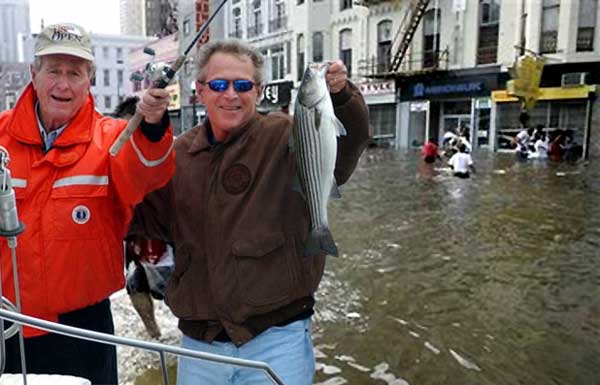
THEY RETURNED
THEY Took Your Jobs
THEY Took Your Homes
THEY Took Your Money
THEY Started Illegal Wars
THEY Destroyed the Economy
THEY Murdered Women & Children
THEY Put Martha Stewart & Tommy Chong In Jail
and... THEY
Held the Teachers Accountable!
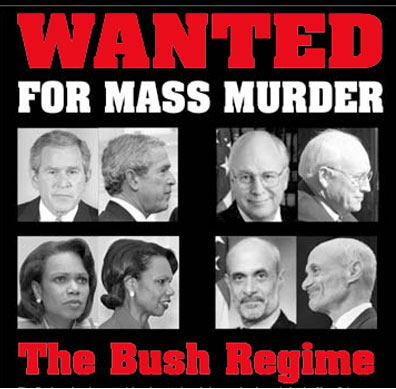
This EVIL
good ol' boy network
Brought Disgrace to the United States
with Republican, Democrat, Senate, Congress, Supreme Court Approval,
AND WALK FREE TODAY.
George Carlin - The Owners of America

Nobody Brought Peace To Our Times
"None of the Above" Should Be On Voter Ballots
Apple investigators allegedly posed as police in iPhone prototype hunt
By Christina Bonnington, 05 September 11, Article Source

Former CEO Steve Jobs handles the iPhone 4 at WWDC 2010 - Photo:
Jon Snyder/Wired.com
A little more light has been shed on the odd story of Apple losing another iPhone prototype in a Bay Area bar in California.
The man who's home was searched by what he believed to be San Francisco Police Department officers was Bernal Heights resident Sergio Calderón, SF Weekly discovered. And the police officers? They may have been investigators working for Apple who were actually impersonating police officers.
Impersonating a police officer is a misdemeanour in California, and is punishable by up to a year of jail time. Another option is that Apple was working with police officers, and a proper report was never filed. When the SFPD has been called and asked about the Apple incident, representatives said they had no knowledge of the search.
"This is something that's going to need to be investigated now," SFPD spokesman Lt. Troy Dangerfield told SF Weekly. "If this guy is saying that the people said they were SFPD, that's a big deal."
On Wednesday CNET News.com reported that in late July an Apple representative lost a "priceless" next generation iPhone prototype in San Francisco bar Cava 22. Apple reportedly used GPS to track the phone to a Bernal Heights area home, where police officers were given permission to search the home for the device. The resident was offered money by Apple for the iPhone's safe return, but it was not turned in. The phone was sold on Craigslist for $200, according to CNET, but no independent evidence of the post has surfaced.
The incident is reminiscent of what happened last year when an iPhone 4 prototype was left at a Redwood City bar, and purchased for $5,000 (£3,090) by Gizmodo.
Here's what went down, according to the new report by SF Weekly:
Calderón said that at about 6pm six people -- four men and two women -- wearing badges of some kind showed up at his door. "They said, 'Hey, Sergio, we're from the San Francisco Police Department.'" He said they asked him whether he had been at Cava 22 over the weekend (he had) and told him that they had traced a lost iPhone to his home using GPS.
They did not say they were there on Apple's behalf, but they said that the "owner of the phone" would offer Calderón $300 (£185) for the phone.
Calderón told SF Weekly that he was threatened by the law-enforcement officers when they visited his house, and said that he has no knowledge of the prototype.
One of the officers who visited the Calderón household was a man named "Tony". He left his phone number with Calderón in case he discovered any information about the lost phone. It turns out the phone number belongs to an ex-cop named Anthony Colon, who apparently now works for Apple. A search on LinkedIn found that Colon works as a special investigator for Apple and is a former San Jose police officer. That page is now removed from the site, but caches can still be viewed.
This tale keeps getting weirder and weirder. Apple hasn't returned phone calls on the matter from Wired.
'Jesus' mobile phone ad banned
Watchdog received almost 100 complaints that Phones4U advert 'mocked and belittled' the Christian faith
Mark Sweney, guardian.co.uk, Wednesday 7 September 2011 07.11 BST, Article history, Article Source

Phones4U's 'Jesus' ad was banned by the ASA.
The advertising watchdog has banned a mobile phone ad featuring an image of Jesus Christ after receiving almost 100 complaints that it "mocked and belittled" the Christian faith.
Phones4U ran a national press campaign featuring a cartoon-like image of Jesus Christ giving a thumbs up and promoting "miraculous" deals on Samsung Android phones at Easter.
The Advertising Standards Authority received 98 complaints that the ads – two versions ran in national press – were offensive and the use of the term "miraculous", especially during Easter, was disrespectful to the Christian faith.
Phones4U, which is known for its cheeky advertising, said it had aimed to create a "light-hearted, positive and contemporary image of Christianity relevant to the Easter weekend".
The ASA said the imagery and text of the ads "gave the impression that they were mocking and belittling core Christian beliefs".
It added that they were "disrespectful" to the Christian faith and were likely to cause serious offence. The ASA banned the ads from running.
Phones4U said in hindsight it understood the reaction and regretted any offence caused.
The company, which had chosen to withdraw the ads following direct complaints from the public, said it had no plans to run any similar campaigns.
Stadium-sized artificial floating volcano aims to fix Earth's climate
By Mark Brown, 02 September 11, Article Source

Photo:
Flickr.com/vera.1955
Climatologists are about to embark on a major experiment in geoengineering -- where humans deliberately manipulate the Earth's natural systems to offset the impacts of climate change -- with an artificial volcano floating miles above the Earth.
Volcanoes belch chemical particles into the atmosphere, which reflect solar radiation and reduce surface temperatures on the planet. Researchers from various UK universities want to mimic this activity by spraying out sulphate aerosol particles from a 20km-high, stadium-sized balloon.
It might sound like the barmy plan of a comic supervillian, but the concept is serious. The Cambridge, Oxford, Reading and Bristol universities' SPICE proposal -- aka Stratospheric Particle Injection for Climate Engineering -- received a £1.6 million government grant and EPSRC backing in 2010.
Now, the British engineers are nearly ready to put their plan into fruition, and The Guardian notes that the team will carry out its first field test in October. The opening experiment will be seriously scaled down -- just 0.6km high, a smaller balloon and water droplets instead of sulphate -- to see if the plan is even feasible.
In its secret location out at sea, the water-spewing balloon will be connected to a ship by a tethered hosepipe. This will feed those water droplets to the buoyant, geoengineering zeppelin in the sky. If the plan works, the team will move onto bigger balloons, higher altitude and -- eventually -- sulphate aerosol particles. [Note: View Comments at Source]
Eat The Rich (Yum Yum) - via Vicki
Performed by Original Blackberri at the FREE RADICAL MUSIC AT BUCK'S hosted by Tommi Avicolli Mecca
Why Ministers of Satan Congress Do Not Want to Tax the Rich
The bible warns Satan's demons take on the image of God, similar to that done in Eden, (How else do they gain control of earth?): II Corinthians, 11:14
The Antichrist is variously understood as being a consummately evil system of government or leader.
The Antichrist will be a leader who deceives many people.
The Antichrist will divide the world and create war without end.
The Antichrist will declare that things which are evil to be good.
The Antichrist will refer to war as peace, death as a solution for justice, and serving the wealthy as a means of helping the poor.

"Yes We Can" - CAUTION: Vehicle may be Transporting Political Promises!
Karl Cohen - Association International du Film d'Animation-SF Newsletter - September 2011 - A really big issue with a long interview that explains how the voice acting business works, an article that explains the importance of Cars 2 to Disney, two articles about animation school educations (THE "NY TIMES" RAN A GLOOMY REPORT ON THE JOB PROSPECTS FOR RECENT FILM GRADUATES and THE ART INSTITUTE CHAIN OF SCHOOLS IS INCLUDED IN DEPT. OF JUSTICE MULTI-BILLION DOLLAR LAW SUIT AGAINT FOR-PROFIT COLLEGES), two obits, a book review, lots of new items, a few good animated films to see online and much more. [Click to Continue Reading]
DigiNotar SSL certificate hack amounts to cyberwar, says expert
Dutch government revokes certificates used for all its secure online transactions, while CIA, Google, Microsoft and others affected by hack called 'worse than Stuxnet'
Charles Arthur and agencies, guardian.co.uk, Monday 5 September 2011 18.14 BST, Article history, Article Source

The Dutch government has revoked all trust in digital certificates issued by DigiNotar
The Dutch government says hackers who broke into a web security firm in the Netherlands last month issued hundreds of bogus security certificates that could be used on websites including the CIA and Israel's Mossad, as well as internet giants such as Google, Microsoft and Twitter.
More than 500 fake certificates, including some which could be used to send fake Windows updates to computers, and others which could be used when connecting to the CIA's site, were fraudulently issued in the hack, which occurred in July.
The Dutch government took the exceptional step of calling a press conference at 1.15am on Saturday morning to announce that it was revoking all trust in digital certificates issued by DigiNotar, which until then had been used for all online tax returns filed in the Netherlands.
The government said that browser companies are now rejecting all security certificates issued by the hacked firm. Microsoft's Internet Explorer, Mozilla Firefox and Google's Chrome will all reject certificates from the company. Apple systems require a manual update. Apple has not made any statement on whether it will revoke DigiNotar certificates.
The fake certificates could in theory be used to monitor users' communications with those sites without them noticing, but only by an organisation that also has the ability to reroute internet traffic to servers they control – most likely a government.
Iran's government has been suspected of involvement in the hack, which led to the creation of hundreds of fake security certificates used to create cryptographically secure links between users and sites. A handful of Iranian users of Google's popular email service are known to have been affected by the faked certificates, which would allow a "man in the middle" attack, where an apparently secure link could in fact be tapped by an intermediary. Security experts noted that earlier this year, Iran announced that it was changing the setup for its domain name servers (DNS) used to make connections to sites – which would give it the ideal opportunity to insert faked certificates into the system.
Roel Schouwenberg of the security company Kaspersky warned that the long-term effects of the DigiNotar hack could be more serious than Stuxnet, a computer "worm" that is believed to have been written by US and Israeli computer experts to attack Iran's nuclear facilities by destabilising computer-controlled systems in its uranium centrifuges.
"The attack on DigiNotar will put cyberwar on or near the top of the political agenda of western governments," he noted on the Securelist blog. "I remain with my stance that a government operation is the most plausible scenario."
He added: "The damage sustained to the Dutch (government) IT infrastructure is quite significant. A lot of services are no longer available. Effectively, communications have been disrupted. Because of this one could make an argument the attack is an act of cyberwar."
What a War Criminal Republican Bush Administration,
with Democrat help, Has Done to the Average U.S. Citizen:
Suspect America - Illegal Patriot Act - Illegal Wiretapping
After 9/11, the government began encouraging local police, private security and everyday Americans to report so-called "suspicious activity" that may indicate a security threat. Taking photos of landmarks, walking "nervously" and writing in a notebook are all activities that have led to people being stopped and questioned. Could you be next?
9/11 memorials: the New York fringe
On the eve of 9/11, Charlie Skelton attends LibertyFest, a loose gathering of activist groups in New York
Charlie Skelton, guardian.co.uk, Monday 12 September 2011 00.31 BST, Article history, Article Source
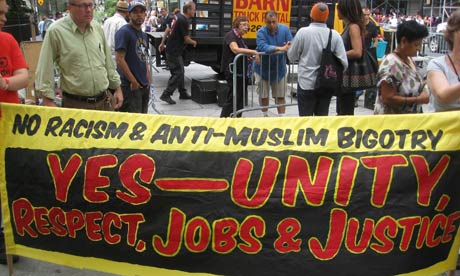
A banner outside LibertyFest in New York. Photograph: Charlie Skelton
All around New York, as evening fell on the 10th, people were drawn towards the glowing doorways of fire stations – and you could hear the fire trucks singing along the streets, answering the waves and whistles from the sidewalks with playful little wailings of their sirens. With their bright livery and bells, the fire trucks feel like the priests of this anniversary, swooping up and down the aisles of a giant church, calling the grateful to prayer.
Meanwhile, in a club in Hell's Kitchen, the night before 9/11 is marked with a very different sort of gathering. Literally the first words I hear from the stage when I step through the door of LibertyFest are: "If you're one of those people who believe everything the government tells you about what happened on 9/11, you're a fucking moron."
Activist Adam Kokesh is in full flight. He claims the attacks of 11 September had a goal, "and the goal was to make America look like it does today". Angry whoops from the floor. This is a gathering of people who are extremely unhappy about what America looks like today. Although their anger is softened by the setting: a cavernous industrial disco, with Night Fever glitterballs, skittering neon lights and shimmering roofhangings.
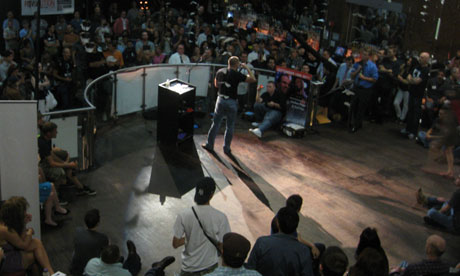
The crowd at LibertyFest. Photograph: Charlie Skelton
Kokesh ended his talk on an upswing, celebrating the liberties that citizens have today: "how awesome to be a human being in 2011" he opined, to happier whoops.
A tour of the disco revealed LibertyFest as a loose gathering of activist groups, each with their trestle table of shirts and leaflets: we had constitutionalists and silver sellers, free marketeers and "Manhattan Libertarians". Lots of fans of Ron Paul. No fans of the Federal Reserve.
Behind one spread of books and badges was Sheriff Richard Mack. I dragged him outside for a chat before his speech. Mack is a former sheriff from Arizona, and on the board of directors of "Oathkeepers", a movement which encourages military and peace officers to stand by the oath they swore to uphold the constitution. And this, he tells me, is the yardstick by which he judges any politician or president: "Who will keep his oath of office?"
Not Obama, any more than Bush, it would seem. The word "Libya" cuts Mack like a knife. "It's unconstitutional. There is a constitutional way to go to war, but we've not followed it since world war two."
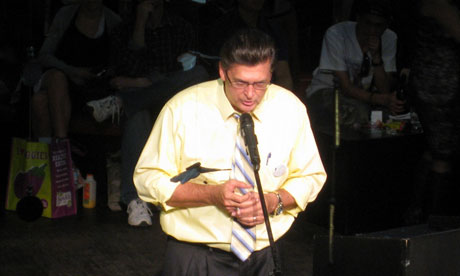
Sheriff Richard Mack speaks at LibertyFest. Photograph: Charlie Skelton
And 9/11? Mack shakes his large head sorrowfully. "It's not been properly investigated. When the government acts like it has something to hide, it makes people suspicious." I remember thinking exactly that when President Bush proudly announced that the original commission would be overseen by none other than (drumroll please) Henry Kissinger. Talk about alarm bells. Fortunately, too many conflicts of interest took Henry's crabbed hand off the tiller, but still …
I ask Mack if he thinks the government is hiding things about 9/11. "Certainly. When you look at how the evidence from people inside the towers has been ignored. When you look at how Building 7 came down. I was in law enforcement for twenty years, and I would dearly love to be on a commission to reinvestigate 9/11."
Don't hold your breath, sheriff. Just a few days ago, it was revealed by Reuters that "the vast majority of the 9/11 Commission's investigative records remain sealed at the National Archives in Washington, even though the commission had directed the archives to make most of the material public in 2009". Might this be a better place to start? – the actual findings of the commission that did (in whatever fashion) investigate the terror attacks.
It's what historians of 9/11 – which is what the activists and investigators essentially are – value most: the paper trail. Documents, statements, memos. This is the grist of history. And if some of the 9/11 activists can tend, sometimes, towards the obsessive, it's generally an obsession with data. And to have that data withheld? It's murder.
So when, at the tail end of LibertyFest, longtime 9/11 activist Luke Rudkowski tells me of the 2.5 terabytes of data from the Able Danger terror investigations that were deleted, it's with genuine pain in his eyes. It's a Ming vase that's smashed on the floor. It's Wayne Rooney looking at a squashed banana. It's a tragedy.
I asked Rudkowski what the "Truthers" were planning for the day. "This year, we're all about paying our respects to the dead. We're sending out a solemn message: we don't know what happened on 9/11, yes we have questions, but on the day we're not asking them. We're going to stand in respectful silence."
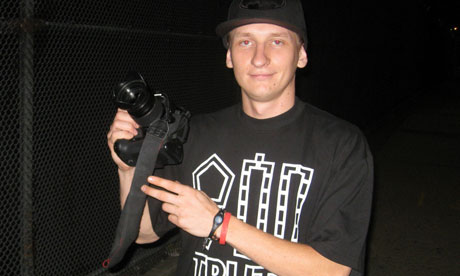
Luke Rudkowski Photograph: Charlie Skelton
But on the night before, Rudkowski is happy to ask. Why, from the 78 security cameras that surround the Pentagon, have we been shown just a few blurry frames? Why has the FBI classified its official investigation into the fact that some of the hijackers were trained at US military bases…?
And what would he say to those who'd scoff at asking such questions? "I'd say, look at the evidence and make up your own mind. And remember, 9/11 is a gigantic event that's going to affect us all for the next hundred years, but it's an event a lot of people know very little about."
And with that, I slid away from the party, and bought some toothpaste from a late night store. I'm not going to mark the tenth anniversary of 9/11 with dirty teeth. I'm glad that the New York Truthers aren't planning anything big and brash for the anniversary. The living will still have their questions, documents will need to be declassified, evidence sifted and lies challenged, but the anniversary of 9/11 is about the dead. The truth can take the day off.
The Next Wave of Botnets Could Descend from the Skies
Researchers are developing hacking drones that could build a wireless botnet or track someone via cell phone.
BY ROBERT LEMOS, WEDNESDAY, SEPTEMBER 7, 2011, AUDIO, Article Source

Hacking on high: The SkyNet drone, built from a toy quadricopter
and a small computer, can fly for up to 13 minutes, or land and then
operate for nearly two hours. -
Credit: Stevens Institute of Technology
The buzz starts low and quickly gets louder as a toy quadricopter flies in low over the buildings. It might look like flight enthusiasts having fun, but it could be a future threat to computer networks.
In two separate presentations last month, researchers showed off remote-controlled aerial vehicles loaded with technology designed to automatically detect and compromise wireless networks. The projects demonstrated that such drones could be used to create an airborne botnet controller for a few hundred dollars.
Attackers bent on espionage could use such drones to find a weak spot in corporate and home Internet connections, says Sven Dietrich, an assistant professor in computer science at the Stevens Institute of Technology who led the development of one of the drones.
"You can bring the targeted attack to the location," says Dietrich. "[Our] drone can land close to the target and sit there—and if it has solar power, it can recharge—and continue to attack all the networks around it."
Dietrich and two students presented [PDF] details of their drone, dubbed SkyNet, at the USENIX Security Conference in mid-August. They used a quadricopter—a toy that costs less than $400—to carry a lightweight computer loaded with wireless reconnaissance and attack software. They controlled the homemade drone with a 3G modem and two cameras that send video back to the attacker. It cost less than $600 to build.
The researchers showed that the drone can even be used to create and control a botnet—a network of compromised computers. So instead of controlling a botnet via a command-and-control server on the Internet—a common technique that can lead investigators back to the operator—the hackers can issue commands via the drone. This method creates an "air gap"—where two systems, or networks, are physically separated—that could prevent investigators from identifying those responsible for an attack.
In the past, others have demonstrated radio-controlled planes and model rockets capable of scanning for wireless networks. A pair of security consultants also unveiled a repurposed Army target drone at the Black Hat Security Briefings conference in August that could scan for and compromise wireless networks. Dubbed the Wireless Aerial Surveillance Platform, or WASP, the drone flies fairly silently. It can find and track cell phones, illustrating another use of the devices, said one of the presenters, Richard Perkins, a security consultant to financial institutions.
"We could identify a target by his cell phone and follow them home and then focus on attacking their less secure home network," he says.
In both cases, the drone attacks are designed to get around the heavily guarded "front door" of information networks—the main connection to the Internet. Wireless networks are typically less secure.
"People see the threat coming from the Internet," Dietrich says. "What they are forgetting is that behind their back, there is that wireless network that may not be properly protected."
The best defense against wireless attacks is to be aware of what's happening on internal networks, says Tom Kellerman, chief technology officer of the wireless security firm AirPatrol. "If you are a Fortune 1,000, you should be concerned, because competitive intelligence has evolved," he says. "It has taken on a whole new arsenal of capabilities due to cyber and wireless."
Companies should have technology to detect rogue devices on their networks and lock down their existing wireless access points, he says.
Chasing Nature
Small flying robots inspired by birds and bugs may do tasks like search and rescue more efficiently.
BY TOM SIMONITE, Article Source

As engineers begin to build tiny aircraft for tasks such as military-related surveillance and post-disaster search, they are turning to nature for inspiration. Conventional aircraft designs can be scaled down only so far, but birds and bugs are a fruitful source of alternative blueprints for cheap, agile miniature flying vehicles. - Credit: Christopher Harting
Toy Drone

Instead of using a traditional remote, this flying toy can be controlled by any iPod Touch or iPhone running special software. A camera communicates with the controller over a Wi-Fi connection, delivering a pilot's-eye view to the user's screen. Graphics representing enemy planes can be overlaid on this view with augmented-reality technology, and the AR Drone can dogfight with them. Thanks to all the onboard processor power available, it can take advantage of technology that keeps it much more stable in flight than similar toys. As a second camera scans the ground below, the Drone automatically adjusts its engines to keep it flying level or hovering. - Courtesy of Parrot - Article Source
Heads Up - Using Apple Leapord 10.5.x ? = Stop Using Safari
There is an article in the September 2011 archive titled: "DigiNotar SSL certificate hack amounts to cyberwar, says expert" (near the bottom) and the majority of browsers (Firefox, Explorer, Opera, Chrome, etc.) have issued fixes; however, APPLE only issued a fix for Snow Leopard 10.6.x. If you have Leopard 10.5.x stop using Safari, it is no longer safe.
9/11: A Conspiracy Theory via Phoenix
Tony Bennett and Amy Winehouse - Body and Soul
The Man Who Was an Early Mentor for Clifford Brown
by Steven Leech, Sunday, September 4, 2011, Article Source
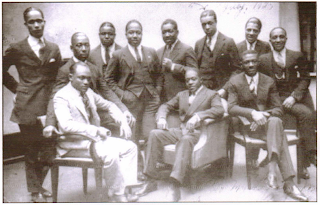
Photo provided by Steve Leech
My friend Ken Anderson has been on me for some time about Sam Wooding, who for a time taught band at Wilmington's Howard High School in the 1940s. Before desegregation began its long process of integrating Wilmington's public schools, Howard High School was the all Black high school in northern New Castle county. Howard High School produced a number of well known and talented musicians, the major figures being Clifford Brown, Lem Winchester and Gerald Price. Clifford Brown had gone to Howard High School in the 1940s and he and my friend, Ken Anderson, were in the Howard High School band together and Sam Wooding was their band teacher. Ken was given the tuba to play and strongly suggests that Wooding may have given Clifford Brown the trumpet. However, Brownie had already adopted the trumpet on his own after giving the trombone a whirl, and probably picked up his first chops under Wooding's tutelage. So who was Sam Wooding?
Sam Wooding was born in Philadelphia on June 17, 1895. In the 1920s he formed a jazz band, performed some vaudeville gigs as well as a few venues in Harlem, notably at Small's Paradise. Soon he realized he could make more money for himself and his band, The Chocolate Dandies, by touring Europe during the 1920s. Among the early jazz greats in The Chocolate Dandies were Doc Cheatham, Tommy Ladnier and Gene Sedric. He recorded some sides for Parlophone and Pathé, and performed in clubs throughout Europe. One song he recorded, "J'ai Deux Amours," was heard by Josephine Baker, who made it one of her signature songs. There is also strong conjecture that the German composer Kurt Weill was influenced by Sam Wooding. The music Weill composed for The Three Penny Opera and other collaborations with Bertolt Brecht contains musical forms reminiscent to those heard from Wooding's arrangements.
In 1927, Wooding and The Chocolate Dandies toured South America and had some momentous gigs in Buenos Aires. One could contend that their influence there had some affect upon Argentina's tango musicians because tango music later merged with big band music, particularly during the Peronist era. Wooding's Chocolate Dandies returned to Europe for a spell in the late 1920s into the early 1930s, but the rise of Nazism eventually drove them out of Europe. The band eventually disbanded after returning to the United States in 1932, but not after reforming for a few years during which Sidney Bechet was a member.
Sam Wooding returned to school after leaving the music industry. He earned a Master's Degree from the University of Pennsylvania, which eventually brought him to a teaching position at Howard High School in Wilmington sometime after 1942 by best estimation. He evidently remained at Howard through at least the late 1940s, leaving his mark upon some later notable musicians like Clifford Brown, which is where we began.
Sam Wooding moved in and out of the music industry afterwards until he died on August 1, 1985.
A Murder in Georgia

TROY ANTHONY DAVIS
http://www.troyanthonydavis.org/
by: Robert Wilbur, Truthout News Analysis, Monday 12 September 2011, Article Source
On Tuesday, September 6, a Chatham County Superior Court judge put the final stamp on a 19-year battle to save the life of an innocent man from Georgia's executioner.
On that date, Judge Penny Freeseman signed a death warrant for Troy Anthony Davis, setting his execution between September 21 and September 28; the exact date will be decided by Georgia's Department of Corrections.
Freeseman's death warrant derives from a ruling by US District Judge William T. Moore Jr. that upheld Davis' conviction for killing a Savannah police officer in a bungled hold-up attempt. Subsequent to the jury's verdict, seven of nine witnesses came forward and recanted their testimony on the basis that they had been intimidated by the police. What's more, a new suspect, Sylvester "Redd" Coles, was identified as the actual shooter. But this was not enough for good ole boy Moore, a product of Southern justice.
The American system of justice turned a deaf ear to Davis, year after year, appeal after appeal. Seemingly, it is more important to demonstrate that the system "works" rather than that it unmasks the truth - no matter that the price is going to be the life of an innocent man, especially a black man. Lynching is alive and well in America - no matter that eminent figures from former-President Jimmy Carter to Pope Benedict have called out for justice in the case of Davis.
Judge Penny Freeseman's death warrant amounts to a license to murder. The Davis case cries out for a new trial with a change of venue to a state like New York where jurors can hear how Savannah cops extracted "testimony" from nine people who happened to be at the scene of the crime. Of course, this is not going to happen. Davis' final appeal to the Supreme Court was turned down without comment. Theoretically, the Georgia Board of Pardons and Paroles can grant clemency, but it has already turned down Davis' appeal once and is unlikely to reverse itself. Moreover, their fax and email addresses are presently unresponsive. (However, Davis' sister, Kim Davis, has a petition at Change.org which she intends to present to the Georgia State Board of Pardons and Paroles on Monday, September 19, at a hearing scheduled two days before Troy's execution. You may sign that appeal for clemency here.)
This means that, after 19 years, Davis will keep his appointment with the executioner. He will be strapped to a death gurney, catheters will be slid into his veins and deadly chemicals will be flooded into his circulatory system. If the execution is carried out properly, Davis will die uneventfully. Otherwise, he will die in agony. But whichever way he goes, Americans can rest assured that justice has been served, from the county courthouse all the way up to the Supreme Court - no matter that the verdict flies in the face of the evidence.
"Do not stand idly by while your neighbor's blood is shed.” (Leviticus 19:16)
The real shooter could possibly be tried by the Fed for violating his victim's civil rights. Truthout readers could deluge Attorney General Eric Holder with phone calls, telegrams and letters to open an investigation as soon as possible: 202-353-1555.
RELATED:
2007 - Georgia AG comfortable with executing innocent - Georgia is moving forward on July 17 with the execution of a man convicted of killing a police officer on the basis on nine eye-witness statements. Since his conviction, six of the nine have recanted their testimony, and one of the nine has confessed to the crime. Problem is, the 1996 law passed to prevent Timothy McVeigh from dragging out his appeals is preventing the introduction of this evidence to prevent the execution. Scary statement of the week: the state Attorney General is "comfortable" with moving forward with the execution.
http://www.flyingsnail.com/200707.html
2008 - EXECUTION HAS RETURNED Georgia comfortable with executing innocent Supreme Court To Decide Fate of Troy Davis: Does Innocence Matter? - Yesterday, with less than two hours left till his scheduled execution, The US Supreme Court intervened in the case of Troy Anthony Davis of Savannah GA. Davis was convicted of murder in the killing of a policeman in 1989. But since then seven of the nine non-police witnesses have recanted their stories, all alleging threats and coercion from prosecutors and/or police. The question raised by the campaign to free Troy Davis, which the Supreme Court will decide soon --- does innocence matter?
http://www.flyingsnail.com/200810.html
In search of Nirvana
Twenty years ago an album that wreaked havoc on the conventional music industry was released. Lauren Spencer, who was among the first to hear Nevermind, reminisces with the surviving band members, and returns to Seattle to hear how Kurt Cobain changed music for ever
Lauren Spencer, The Observer, Sunday 18 September 2011, Article history, Article Source
Nirvana - Drain You (Live & Loud)
[Note: The article listed this video, Nirvana live at the Paramount in Seattle in 1991, not the one above, which was my choice. ~@~]
Twenty years ago on a hot, smelly mess of an August day, the kind New York City does so well, I crossed the lobby of a swanky hotel in Manhattan to interview a band. They were in town to promote their first major-label release, Nevermind, and because I worked for Spin magazine, I'd been sent an advance of the music. It had caused me to miss my stop on the subway so confused and smitten was I by the soft and hard edges of the tunes and lyrics coming through my headphones. So I was heading up to meet these guys who called themselves Nirvana and find out for myself how they put heaven and hell into each of the songs.
When I stepped into their closet-sized room – twin beds, one chair, one table – I was met by Kurt Cobain, singer- songwriter, guitarist, and David Grohl, the man of drums. Bassist Krist Novoselic had a prior engagement and was not able to join us. That they looked not so much like up-and-coming rock stars as kids whose parents had left them to their own devices – and whose activities may have included bouncing on the beds and making prank phone calls – was heartening, as I was thoroughly sick of the slick interviews I'd been encountering with top-40 rock outfits. Our conversation encompassed homemade tattoos and why Cobain chose the K symbol for his, representing the Washington indie label of the same consonant; that night's free-for-the-fans Metallica party at Madison Square Gardens that they were eager to get into; and how much they loved the trailblazing Sonic Youth.
The fact that within the next few years Nirvana would pave the way for Sonic Youth and other like-minded alternative groups to find a larger audience, as Nevermind toppled pop giant Michael Jackson from his number one spot on the US Billboard charts, was impossible to forecast from this early 90s vantage point, where Bryan Adams's "(Everything I Do) I Do It For You" had been dominating both British and American airwaves for weeks. There was something in this Seattle-based band's songs, live performance and attitude that quickly set the rock 'n' roll industry on its ear, so that what had once been considered an underground sound would emerge to wreak havoc on conventional record chart rankings and traditional music business models.
When I left to go on holiday to Greece the next week, I took Nirvana's music with me. The band imprinted my vacation with incongruities: the clear blue beauty of the Aegean sea and the fuzz-fest mayhem of "Territorial Pissings", a hot shimmering Mediterranean sun infected with the chilling strains of "Polly". It all clashed so beautifully that it woke me up from the Guns N'Roses/Mötley Crüe-like torpor I'd been sunk into of late.
I certainly wasn't alone in responding to that call, as I witnessed on 24 September 1991, the day of Nevermind's release, when I went to Boston to see Nirvana live for the first time. The show was at a club called the Axis, which was apt, since the earth really did seem to shift during their performance. The energy was palpable from the first notes of their cover of the Vaselines's "Jesus Doesn't Want Me for a Sunbeam" and through to their own single "Dive". The notes screamed and bounced off the walls, sweat flew from onstage and off, all combined with incredible melodies while hundreds of kids shook the foundation of the building in their abandon.
There was a sense that the wall separating so-called mainstream music from what was real and raw was being pounded into rubble in front of our eyes by Nirvana's aural celebration and rage. That it all blew completely apart three short years later on 5 April 1994 when Cobain put a shotgun to his head was both inconceivable and, strangely, almost inconsequential, because though both his life and the band came to a tragic and much-too-early end with that trigger pull, Nirvana's legacy had lodged deeply in the public's consciousness and changed music for ever.
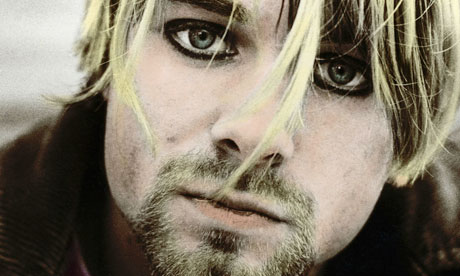
Kurt Cobain
In between Nevermind's release and Cobain's death, a diverse and voracious stream of fans and sycophants turned up in Seattle looking for all things grunge, a word that had been given new purpose by the record and fashion industries. They used it to fold into one saleable mass all the varied sounds and stylings of the myriad Pacific Northwest bands, removing it from its original meaning as the stuff that gets underneath your fingernails. No matter what a band's sound, if they came from Seattle, they were categorised as grunge. The term was supposed to describe the lo-fi rumblings and sonic churn of bands such as the Melvins, one of the original groups on the scene that Nirvana admired, yet for every Melvins there was a Posies, a pop outfit whose clear and crystal melodies were anything but muddy. Bassist Dave Fox remembers that when he was on tour with the Posies, "We were always The Posies From the Town of Grunge, but we were so far removed from that scene."
Another of Seattle's nicknames was even more telling. Emerald City was meant to reference the area's surrounding evergreen forests, but it could also have described the tinge of record company currency that had begun to roll in, and the hue of innocence with which the city faced the oncoming masses. "I remember talking about how weird it was that all these [local] bands were getting signed to major labels," says Megan Jasper, vice president of Nirvana's first official label Sub Pop records, describing the aftermath of the 1991 release of Nevermind.
"Suddenly, the clubs didn't feel so empty," she says, "because people were coming in from other parts of the country since they'd heard something was going on here. You'd be walking to a club and someone would pull over and ask, 'How do you get to the Croc-o-dial café?' You'd think, 'Oh, fuck,' because that's where you were going and you didn't know who these people were."
Seattle rock photographer Lance Mercer remembers being amazed when he realised how the scope had changed. "I knew it when Pearl Jam opened for the Red Hot Chili Peppers and Nirvana at the Cow Palace in San Francisco [New Year's Eve, 1991] and I realised two things: one, there was something big going on that I hadn't really noticed; and two, I'd need a much larger lens to capture the action. I had no idea that other people knew Seattle existed. But suddenly I saw the music had all the elements for success. When I first heard 'Smells Like Teen Spirit' on the radio I said, 'Oh man, this is gonna be huge.'"
And the gospel of Nirvana was spreading fast, much more quickly than their record company figured – by using Sonic Youth as their guide they had substantially underestimated how many copies of Nevermind to release. It was clear that the industry would need a new template. Across the country, young people, or at least the young at heart, began to find a muse in their music. Whether Cobain liked it or not – and he frequently made it known how little he did – he was becoming the voice of a generation. Both Nirvana's music and their attitude were beginning to pierce the ultra-slick, airtight container that had up to now held 90s commercial music.
Cobain's often disturbing visual and melodic artistry, mixed with the band members' sense of humour, created a musical model vastly different from the carefully crafted careers the music industry usually constructed with the aid of marketers, stylists and managers. Nirvana were messy. They wore their own clothes and rolled around in their own musical mayhem, giving interviews that often bordered on the absurd, or at least un-checkable, as I found when my researcher attempted to confirm Kurt's last-known address as under a bridge in the logging town of Aberdeen, Washington.
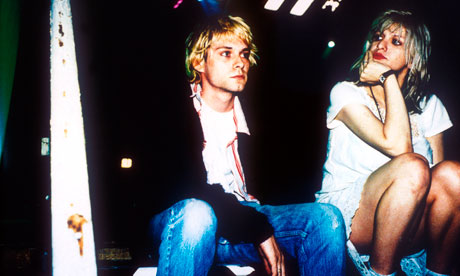
Kurt Cobain and Courtney Love, ‘who could start a war in an empty room’. Steve Pyke/Retna Photograph: Steve Pyke/Retna
Troy Nelson, singer-songwriter, guitarist for Seattle band the Young Evils and DJ at KEXP radio, was a metal-loving teenager in South Dakota when he first encountered Nirvana's music. He couldn't quite make sense of why the band affected him the way it did. "I have a vivid memory of watching MTV and 'Smells Like Teen Spirit' came on," he says. "I was trying to piece together what the hell I was watching. I was completely struck by Cobain's style. They seemed like the stoners next door… like total dorks. But when you're 15 or 16 it felt like they were your friends and they were wreaking havoc. To me Kurt Cobain was the Wizard of Oz. He unveiled the phoniness of so many things. It actually kind of ruined a lot of music for me. But I loved it."
The songs were powerhouses for sure, but the whole package is what counted. "Bands come in and say I want my drums to sound like Dave Grohl's," says producer Butch Vig, who was responsible for the sound of Nevermind. "No matter what I do to this drum kit it's not going to sound like him unless he's the one playing. Maybe that's why there aren't any Nirvana tribute bands – I mean the songs are simple to play, but to pull off their attitude and talent would be hard. It would be easier to pull off a Journey tribute band."
Twenty years almost to the day from when I first entered that New York City hotel on my journey to find Nirvana, I'm standing in another lobby across the country. It's been over a decade and a half since Cobain killed himself and the surviving band members moved on to other projects: Grohl formed the Foo Fighters, Novoselic played bass in the bands Sweet 75, Eyes Adrift and Flipper, and began the non-profit organisation Joint Artists & Music Promotions Political Action Committee. My journey has brought me back to the OK Hotel, a former all-ages club where Nirvana first played "Smells Like Teen Spirit" to a passionate crowd on 8 April 1991. I'm desperate to find something that may smack of the teen spirit that in the early 90s propelled the band into the wider world of music with their raw power, fuck y'all attitude and pop-meets-punk tunes.
But I'm coming up short. I can't find one whiff of the delirious disorder and abandon I used to inhale back in the days when I'd fly out to cover the Seattle scene. There's no sound of music – not even any speakers to pipe it through – no smell of sweat from bodies moving en masse in a too-tiny room. Though the place is practically empty, I'm rooted in the same spot where I'd watched Nirvana, the Fastbacks, Mudhoney and Tad while losing my voice and having my feet stomped on. And now, many years later with Cobain dead and the scene moved on, I find myself instead having an altogether civil and well-modulated conversation about square feet. Because the OK Hotel is now a residential building offering apartments and artist suites, with a gallery planted where the stage and bar used to be.
But there's a perverse sense in this scenario – in light of what transpired, both in Seattle and beyond, in the three years between Nevermind's release and the decorating of the Cobain memorial bench in Viretta Park near the house where he ended his life. Cobain's suicide mummified the band, encasing Nirvana in a layer of nostalgia and removing them from active duty as the agents of change in an industry that seemed to be just opening up to the idea that all shapes and sizes could rock mainstream music. What had made the band so exciting was their attitude, suggesting anyone could experiment in the musical playground and maybe even achieve more than underground success, if that's what they wanted. And it seemed the industry was starting to buy it. But once Cobain was dead, commerce trumped art.
"The thing about Nirvana is that they changed the whole game," says Kurt St Thomas, a DJ at Kroq radio in Los Angeles, who was the first to play Nevermind end-to-end on WFNX in Boston. "Before that album came out there were only a handful of 'alternative' radio stations, and within two years of the record there were more than 100. It should have been a victory, finally good music was getting exposed to more kids who'd never heard stuff like Nirvana, but the radio stations were not really passionate about the music, they were passionate about making a buck, and they started playing Nirvana wanna-bes and watering it down. Once record companies jumped on the bandwagon, it just reeked of business. The image of Spencer Elden [the baby on Nevermind's cover] reaching for that dollar bill is so symbolic to me because that is exactly what it felt like."
After the overindulgence of record companies came the inevitable hangover. Musicians who had been scooped up in the sign-anything-wearing-flannel frenzy found themselves shaken off and having to choose between, as photographer Mercer observed, the blue, the green or the orange apron, signifying a job at either Starbucks, Kinkos or Home Depot.
"So much changed so quickly in the first half of the 90s," says Grohl. "People will tell me how really good that music was, and I agree – a lot of really good music became popular. There was a much more open musical environment and atmosphere. But then it ended up choking itself in a weird way. There were so many bands getting signed from garages and basements from around the country. It was like you left school and had three options: you could either go to college, backpack across the country or start a band and get a record contract – and if it didn't stick, that was when you'd have to go out and get a real job."
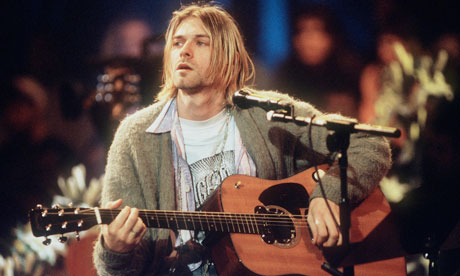
Kurt Cobain fronts Nirvana's MTV Unplugged concert in New York City in 1993. Photograph: Frank Micelotta/Getty Images
It seems Nirvana could have only happened then and there; a tight-knit community of local talent had been developing in Seattle for years, out of the spotlight where they had room to grow. Then a perfect storm combining record company budgets with expanding media outlets like MTV hit Seattle's musical shores, dragging more than a few bodies out to sea. Novoselic points out that, "We were the last musical phenomenon before online took hold. In 1999, Napster happened and nothing's been the same since. Now you have to pull people into the music, whereas before everything was pushed out toward the people. The playing field was levelled but now it's so vast that people have to work harder to be heard."
Wandering around the clubs to see what the Seattle kids are up to today, I was happy to find nothing sounded the least like Nirvana. There were the trance-like, Bolly-rock beats of Rose Windows, followed by Wayfinders, who sound like the thick, rich results of Uriah Heep combined with the Smashing Pumpkins. Later I happened upon Troy Nelson's band, the Young Evils, whose harmonies with Mackenzie Mercer are pop gems with an indie beat. Not once during these shows did the word grunge cross my mind. And yet they might not have been heard but for Nirvana. Nelson admits he moved to Seattle because Nirvana put it on the map, "and I'm still to this day trying to write a song as important as 'Smells Like Teen Spirit'."
"I think of it as a forest fire," says Sub Pop's Megan Jasper. "It just felt like everything went up in flames in Seattle so fast, but once it was out, time passed and there was new growth underneath. It makes room for people to come in and do new things. There was something about being in the shadows of grunge and Nirvana. There was a mindfulness because it was so close, and whatever you do, it needs to be different. I think enough time passed that it was OK to emerge and make things happen again. It's respect on one side and rebellion on the other.
"Most people in Seattle don't live in the past," Jasper continues. "Most people are more excited about the here and now. And thank god for that mindset otherwise this place would just be a ghost town." Though if you're into that kind of thing, there is a museum sitting in the shadow of downtown's Space Needle that's dedicated to preserving and sharing Seattle's musical legacy. It's the Experience Music Project, funded by Microsoft co-founder Paul Allen, and right now there's an exhibition running until April 2013 where all things Nirvana are on display. Called Nirvana: Taking Punk to the Masses, it's an ambitious collection of, according to the programme, "rare and unseen artefacts and photography from the band, their crews and families". Larry Reid, punk promoter and manager, says it feels a bit like they've "fetishised" the grunge scene, though, as Novoselic points out, it's better than seeing Cobain's guitar hanging off the wall at a Hard Rock Café while you're eating chilli fries.
I had pangs of déjà-vu as I stared into the glass case that held the sweater Cobain wore for the cover photo that accompanied my story in Spin; but I was heartened to see that one of the main attractions was a dry-erase board where museum-goers could connect any Seattle band, six-degrees-of-separation style, to Nirvana. The board was packed with the names of bands who appeared to be carrying on the very thing I'd imagine Cobain would have wanted if he'd had a chance to choose a legacy. Namely: We're all in this together, let's make some noise.
The Super Deluxe Edition of Nirvana's Nevermind will be releases on 19 September. The multi-format reissue is schedules for 26 September via Universal Music Enterprises featuring dozens of rare and previously unreleased performances
Beavis and Butthead watch Nirvana (Smells like Teen Spirit)
NEW Beavis and Butthead Episode Preview 2011
A real Wall Street takeover threat
Hundreds of the young and disenfranchised settle into lower Manhattan to send a message to Wall Street -- and Obama
By David Talbot, Sunday, Sep 18, 2011 18:19 ET, Article Source

Demonstrators gather Saturday to call for the occupation of Wall Street. According to its
website, occupywallst.org, the leaderless resistance movement aims to flood thousands of people
into lower Manhattan, set up beds, kitchens, peaceful barricades and occupy Wall Street. Photo: AP
The hundreds of young people who converged on the New York Stock Exchange this weekend are calling their demonstration against Wall Street greed an "American Tahrir Square." While they have a long way to go before they create the tremors that brought down the Mubarak regime, their passion was clearly on display on a sunny Sunday afternoon in Zuccotti Park in lower Manhattan.
The protestors were gathered in the square at the corner of Broadway and Liberty Street, after police blocked them from the epicenter of American finance a couple of blocks away. Many had spent the night in sleeping bags and insisted they were prepared to spend many more to make their point.
"This country is in decline," said Jack Laxson, an 18-year-old Hampshire College student who was carrying a sign that read, "Corporations Run This Country -- Let's Do Something About It."
"Even with a good education, you don't have much to look forward to. No jobs, lots of debt."
Like many of the protestors, Laxson expressed strong disappointment with President Obama, but said the Republican presidential field was even more demoralizing. "They're a social psych experiment," he said.
Matt Rosen, a protestor standing next to Laxson, agreed. "Obama's not on our side -- he's George W. Bush Part Two. And the only Republican candidate who speaks any sense is Ron Paul, and he doesn't stand a chance because the media have blacked him out."
Rosen, a 36-year-old swimming pool contractor from New Jersey, said the bad economy is killing his business. He spent the night in Zuccotti Park, sleeping on a swimming pool cover, because, "If people don't get off the couch, nothing will get done."
"We are mad as hell that the world is as fucked up as it is by corporations," read a leaflet passed out by protesters. "The few who control wealth have bought off our democratically elected leadership."But the mood of the crowd was genial and upbeat.
"Optimism -- that's what brought us down here," said 40-year-old Dan Bryk, who was carrying his eight-month-old son, Henry, in a snuggly while holding a sign saying, "Oligarchy Is Not Healthy for Children and Other Living Things."
"There's a delightful naivete to this crowd," added Bryk.
"Like everyone our age, we're overeducated and unemployed," said Patrick Bruner, a 23-year-old native of Tucson, Arizona who recently migrated to Brooklyn. Bruner said that he and his fellow protestors were prepared to hold the Wall Street square for a long time.
Nearby, volunteers made stacks of peanut butter sandwiches and distributed slices of pizza donated by people who visited the Occupy Wall Street web page. The demonstration had a spontaneous feeling, but underlying it was an extensive social media network. "This is more than just a feel-good rally," said a young man who declined to give his name, as he made cucumber and cream cheese sandwiches. "We're digging in for a long-term occupation."
Troy Davis execution: repeated trips to death chamber 'amount to torture'
Troy Davis has come close to being executed four times – and human rights campaigners describe effects of multiple exposure to imminent judicial death as 'horrendous'
Ed Pilkington, guardian.co.uk, Tuesday 20 September 2011 18.30 BST, Article history, Article Source
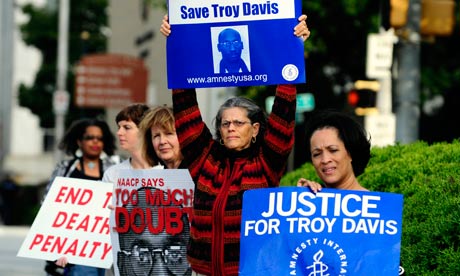
Troy Davis execution: almost 1m signatures have been collected on a petition asking for clemency for Davis. Photograph: David Tulis/AP
Should the execuction of Troy Davis go ahead on Wednesday night as expected, it would be the fourth occasion he has come within a short time of being administered with lethal drugs in as many years.
On 23 September 2008, Davis came within 90 minutes of execution. He was taken off the gurney after the US supreme court intervened.
That was his second execution date. On 16 July 2007 he was granted a stay just one day before he was due to die, and on 24 October 2008, at the third attempt to kill him, he was spared temporarily three days before his execution date.
Experts in death row and its psychological impact on prisoners say that such multiple exposure to imminent judicial death is tantamount to a form of torture. It can induce post-traumatic stress disorder, and human rights campaigners say it should be classified as cruel and unnatural treatment that should be banned, irrespective of the guilt or innocence of the prisoner.
Stuart Grassian, a psychiatrist with extensive experience of treating death row inmates, has had patients who came within hours of death but were later proven to have been innocent. "I have watched what happens to them, and the effects are horrendous. People suffer immeasurably."
One of his patients came close to being executed on the electric chair. "The image of burning up in the chair stayed with him for years afterwards."
Brian Evans, a death row specialist with the US branch of Amnesty, pointed out that under international law, mock executions were considered to be a form of torture. "Troy Davis's treatment was not a mock execution, but it has had the same effect. Especially when he has come within hours of death, and said his final goodbyes – that is certainly similar to torture."
Evans added that the process was also unbearable for the families of victims. "The constant waiting, the many false promises – that's abusive of their rights too."
For many death row prisoners, the prospect of walking the line, possibly several times, proves to be too much. A 2004 study by John Blume of Cornell law school found that 106 of the 822 executions that had then been carried out in the modern era in America involved prisoners who had voluntarily gone to their deaths, eschewing all appeals.
Some see that as a form of judicial suicide.
In the most gruesome cases, prisoners have actually had their executions called off mid-procedure.
In May 1946, Willie Francis, a black boy then aged 17, was put on the electric chair in Louisiana for murdering his white employer the year before. The instrument of death was improperly set up by a drunk prison guard, and Francis screamed out from behind his leather hood: "I'm n-not dying!"
He was taken back to his cell, then executed back on the same electric chair a year later.
On 15 September 2009, Romell Broom was strapped to a gurney awaiting death by lethal injection in Ohio. Executioners struggled to find a useable vein into which to inject the lethal drugs. Broom was reported to wince and grimace, and at one point appeared to be sobbing.
After two hours, the then governor of Ohio, Ted Strickland, called the execution off. Broom was returned to death row, where he remains today.
beyond any reasonable doubt?
Troy Davis: 10 reasons why he should not be executed
With just a few hours to go until Troy Davis is executed in Georgia, despite serious doubts about his guilt, here are 10 reasons why the death sentence should not be carried out
Ed Pilkington in Jackson, Georgia, guardian.co.uk, Wednesday 21 September 2011 19.04 BST, Article history, Article Source
In 2007 the Georgia Board of Pardons and Paroles, the body which has the final say in the state on whether executions should go ahead, made a solemn promise. Troy Davis, the prisoner who is scheduled to die by lethal injection at 7pm local time on Wednesday, would never be put to death unless there was "no doubt" about his guilt.
Here are 10 reasons why the board – which decided on Tuesday to allow the execution to go ahead – has failed to deliver on its promise and why a man who is very possibly innocent will be killed in the name of American justice.
1. Of the nine witnesses who appeared at Davis's 1991 trial who said they had seen Davis beating up a homeless man in a dispute over a bottle of beer and then shooting to death a police officer, Mark MacPhail, who was acting as a good samaritan, seven have since recanted their evidence.
2. One of those who recanted, Antoine Williams, subsequently revealed they had no idea who shot the officer and that they were illiterate – meaning they could not read the police statements that they had signed at the time of the murder in 1989. Others said they had falsely testified that they had overheard Davis confess to the murder.
3. Many of those who retracted their evidence said that they had been cajoled by police into testifying against Davis. Some said they had been threatened with being put on trial themselves if they did not co-operate.
4. Of the two of the nine key witnesses who have not changed their story publicly, one has kept silent for the past 20 years and refuses to talk, and the other is Sylvester Coles. Coles was the man who first came forward to police and implicated Davis as the killer. But over the past 20 years evidence has grown that Coles himself may be the gunman and that he was fingering Davis to save his own skin.
5. In total, nine people have come forward with evidence that implicates Coles. Most recently, on Monday the George Board of Pardons and Paroles heard from Quiana Glover who told the panel that in June 2009 she had heard Coles, who had been drinking heavily, confess to the murder of MacPhail.
6. Apart from the witness evidence, most of which has since been cast into doubt, there was no forensic evidence gathered that links Davis to the killing.
7. In particular, there is no DNA evidence of any sort. The human rights group the Constitution Project points out that three-quarters of those prisoners who have been exonerated and declared innocent in the US were convicted at least in part on the basis of faulty eyewitness testimony.
8. No gun was ever found connected to the murder. Coles later admitted that he owned the same type of .38-calibre gun that had delivered the fatal bullets, but that he had given it away to another man earlier on the night of the shooting.
9. Higher courts in the US have repeatedly refused to grant Davis a retrial on the grounds that he had failed to "prove his innocence". His supporters counter that where the ultimate penalty is at stake, it should be for the courts to be beyond any reasonable doubt of his guilt.
10. Even if you set aside the issue of Davis's innocence or guilt, the manner of his execution tonight is cruel and unnatural. If the execution goes ahead as expected, it would be the fourth scheduled execution date for this prisoner. In 2008 he was given a stay just 90 minutes before he was set to die. Experts in death row say such multiple experiences with imminent death is tantamount to torture.
Supreme Court Applauds Georgia's
Execution of Reasonable Doubt
Troy Davis execution - in pictures
The prisoner was put to death by lethal injection
after a last-minute appeal to the US supreme court failed
[Some call it: "ObamaCare Unmasked"]
GOD said, thou shall not kill and
JESUS extended this concept when he said,
Christians are to no longer execute sinners, so they should not wage carnal war, but spiritual warfare. - (John 18:36; 2 Corinthians 10:1-6; Ephesians 6:10-18; 1 Timothy 1:18-20; 6:11-14; 2 Timothy 2:3-5; 4:6-8).
Christians must be peacemakers forgiving those who do them harm treating their enemies with love and not seeking revenge. - (Matthew 5:9; Romans 14:19), (Ephesians 4:29-32; Colossians 3:12-14; Matthew 6:9-15; Mark 11:25-26), (Luke 6:27-36), (Romans 12:17-21; 1 Peter 3:8-12).
Hatred which is the same as murder is unforgiving, vengeful and hostile towards one's enemies. - (1 John 3:15)
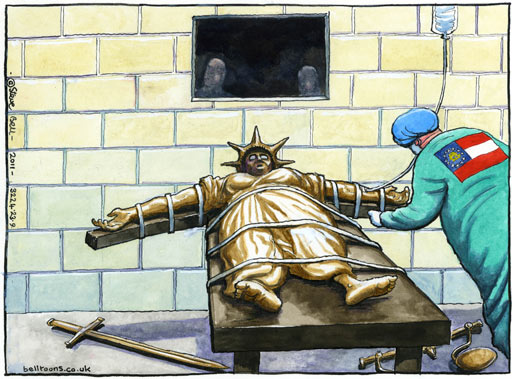
Steve Bell cartoon on the execution of Troy Davis
Then ... There Are the Mass Murderers
Politicians and Judges Allow to Walk Free:
William Calley
From Wikipedia, the free encyclopedia
Calley was charged on September 5, 1969, with six specifications of premeditated murder for the deaths of 104 Vietnamese civilians near the village of My Lai, at a hamlet called Son My, more commonly called My Lai in the U.S. press. As many as 500 villagers, mostly women, children, infants and the elderly, had been systematically killed by American soldiers during a bloody rampage on March 16, 1968. If convicted, Calley could face the death penalty.
On November 12, 1969, investigative reporter Seymour Hersh broke the story and revealed that Calley was charged with murdering 109 Vietnamese.
On April 1, 1971, only a day after Calley was sentenced, U.S. President Richard Nixon ordered him transferred from Leavenworth prison to house arrest at Fort Benning, pending appeal. This leniency was protested by Melvin Laird, the Secretary of Defense. The prosecutor, Aubrey Daniel wrote, "The greatest tragedy of all will be if political expedience dictates the compromise of such a fundamental moral principle as the inherent unlawfulness of the murder of innocent persons."[13] On August 20, 1971, the convening authority — the Commanding General of Fort Benning — reduced Calley's sentence to 20 years. The Army Court of Military Review affirmed both the conviction and sentence (46 C.M.R. 1131 (1973)). The Secretary of the Army reviewed the sentence and findings and approved both, but in a separate clemency action commuted confinement to ten years. On May 3, 1974, President Nixon notified the Secretary that he had reviewed the case and determined he would take no further action in the matter.
Ultimately, Calley served only three and a half years of house arrest in his quarters at Fort Benning. He petitioned the federal district court for habeas corpus on February 11, 1974, which was granted on September 25, 1974, along with his immediate release, by federal judge J. Robert Elliott.

Steve Bell
Libby lied, troops died
The Scooter Libby verdict is inextricably linked to Iraq: his lies were an attempt to cover up the disingenuous case for war.
Sidney Blumenthal, guardian.co.uk, Tuesday 6 March 2007 22.00 GMT, Article history, Article Source
The conviction of I Lewis "Scooter" Libby, Vice President Dick Cheney's former chief of staff, on criminal charges of obstruction of justice and perjury brings only a partial conclusion to the sordid political tragedy that is the Bush presidency. Yet the judgment on this matter goes to the heart of the administration. The means and the ends of Bush's White House have received a verdict from the bar of justice.
Foreign policy was and is the principal way of consolidating unchecked executive power. In the run-up to the Iraq war, professional standards, even within the military and intelligence agencies, were subordinated to political goals. Only information that fit the preconceived case was permitted. Those who advanced facts or raised skeptical questions about sketchy information were seen as deliberate enemies causing damage from within. From the beginning, the White House indulged in unrestrained attacks on such professionals. Revealing the facts, especially about the politically-driven method of skewing policy, was treated as a crime against the state.
For questioning the undermanned battle plan for the invasion of Iraq, Army Chief of Staff Eric Shinseki was publicly humiliated by neoconservative Deputy Secretary of Defense Paul Wolfowitz and then cashiered. For disclosing negligence on terrorism before the Setempber 11 attacks, counterterrorism chief Richard Clarke was accused by then-National Security Adviser Condoleezza Rice of acting purely out of motives of personal greed to promote his recently published memoir. For exposing the absence of rational policymaking in economics as well as foreign policy, Secretary of the Treasury Paul O'Neill was threatened with an investigation for allegedly abusing classified material. Once he was intimidated into silence, the probe was dropped.
In the aftermath of former ambassador Joseph Wilson's revelation that the most explosive reason given for war against Iraq - that Saddam Hussein was seeking yellowcake uranium in Niger to fuel nuclear weapons - had no apparent basis in fact, the Bush White House revved into high gear against the critic. Wilson, however, was even more dangerous than the others because he was a witness to the false rationale for the war.
As Libby's defense counsel insisted, Scooter was merely one of many in the White House assailing Wilson's integrity. Others, including Bush's political strategist Karl Rove, were involved. To a degree, the smear campaign was for a time successful, fueled by the Republican-controlled Senate Intelligence Committee and elements of the Washington press corps. But the trial exhibits - documents entered by the special prosecutor - knocked down every single one of their falsehoods.
Libby's defenders argued that there was no underlying crime. He was not charged with revealing the identity of Valerie Plame, Wilson's wife, as a covert CIA agent, which was a charge raised by the White House gang in an effort to prove she sent Wilson on his Niger mission - another of the lies spread about him.
But Libby committed his crimes to cover-up the role of his boss and to protect his own position in the attack on Wilson. At base, then, the reasons for war were the scandal.
Libby was no mere factotum. He was a central member of the neoconservative cast of characters, who began as a protégé of Wolfowitz and was elevated to the role of Cheney's indispensable man.
Libby's conviction not only indelibly stains neoconservatism. It is a damning condemnation of the Bush White House belief that the ends justify the means and its aggrandizement of absolute power. Ultimately, this is a verdict that can never be erased from the history of the Bush presidency.
Republicans - Reagan/Bush and Bush/Quayle
Supplied Iraq With Chemical, Biological, and
Other Weapons of Mass Destruction
Between 1983 and 1992--the Reagan/Bush and Bush/Quayle era--the U.S. gave Iraq innumerable weapons, and issued about $2 billion in loans, most of which were used to buy even more weapons; the U.S. never expected full repayment. In addition, U.S. corporations provided Iraq with the means to manufacture chemical and biological weapons. The "point man" the Reagan administration sent to solidify U.S.-Iraqi relations--and who had personal knowledge that Iraq was using chemical weapons against Iran, and who helped remove the "terrorist" label against Iraq--was . . . Donald Rumsfeld. - Permmalink Source
Republicans and Democrats are Lying Hypocrites
Who Support Selective Terrorism Against U.S. Military
Israeli Terrorists:
Attacked the U.S.S. Liberty - 34 U.S. Military Dead, 171 Wounded
Bush, Cheney, Rumsfeld, Rice:
Authorize Sodomy of Children
Seymour
Hersh's ACLU Keynote Speech
[transcribed on "Past Peak - Cause for Alarm"]
Seymour Hersh says the US government has videotapes of boys being sodomized at Abu Ghraib prison in Iraq.
"The worst is the soundtrack of the boys shrieking," the reporter told an ACLU convention last week. Hersh says there was "a massive amount of criminal wrongdoing that was covered up at the highest command out there, and higher."
(Streaming Audio of his speech from this streaming site. Hersh starts at about 1:07:50.)
He called the prison scene "a series of massive crimes, criminal activity by the president and the vice president, by this administration anyway…war crimes."
The outrages have cost us the support of moderate Arabs, says Hersh. "They see us as a sexually perverse society."
Hersh describes a Pentagon in crisis. The defense department budget is “in incredible chaos,” he says, with large sums of cash missing, including something like $1 billion that was supposed to be in Iraq.
"The disaffection inside the Pentagon is extremely acute," Hersh says. He tells the story of an officer telling Rumsfeld how bad things are, and Rummy turning to a ranking general yes-man who reassured him that things are just fine. Says Hersh, "The Secretary of Defense is simply incapable of hearing what he doesn't want to hear."
The Iraqi insurgency, he says,was operating in 1-to-3 man cells a year ago, now in 10-15 man cells, and despite the harsh questioning, "we still know nothing about them...we have no tactical information.”
He says the foreign element among insurgents is overstated, and that bogeyman Zarqawi is "a composite figure" hyped by our government.
The war, he says, has escalated to "full scale, increasingly intense military activity."
Hersh described the folks in charge of US policy as "neo conservative cultists" who have taken the government over, and show "how fragile our democracy is."
He ripped the supine US press, pledged to bring home all the facts he could, said he was not sure he could deliver all the damning info he suspects about Bush administration responsibility for Abu Ghraib.
Plastic natural gas pipe failure data kept secret
Jaxon Van Derbeken, Chronicle Staff Writer, Monday, September 26, 2011, Article Source

Click to View All Five (5) Images
The type of plastic pipe that caused a natural gas explosion and fire in a Cupertino condominium last month has long been considered a potential threat to the public, but federal pipeline regulators have allowed companies to keep it in the ground and secretly gather limited information about its failings, a Chronicle investigation shows.
Companies such as Pacific Gas and Electric Co., which owns the line that caused the Cupertino blast, don't have to routinely report what they know about failure rates of particular brands of plastic pipes, even to the federal and state agencies that regulate pipeline operators. The federal government, bowing to industry resistance, has never required it.
Officials with the California Public Utilities Commission, which oversees PG&E, say the utility does account for plastic pipe leaks in quarterly reports, but does not indicate the maker of the pipes involved. PG&E provides that and other key information about plastic pipe failures on a voluntary, anonymous basis to an industry-maintained confidential database.
Timothy Alan Simon, one of the five PUC members appointed by the governor, said that should change.
"These are gas lines coming to your home," Simon said. "Every resident should have a certain level of assurance that we are not hiding information that they need to know to determine safety."
Cupertino blast
The Cupertino condominium was gutted Aug. 31 after a plastic pipeline fitting cracked, filling the garage with gas that exploded just minutes after the owner left for lunch. PG&E later found six other plastic pipe failures near the blast site.
The line was an especially problematic type of pipe manufactured by DuPont called Aldyl-A. PG&E has 1,231 miles of the early-1970s-vintage pipe in its system.
Federal regulators singled out pre-1973 Aldyl-A starting in 2002 as being at risk of failing because of premature cracking. Explosions caused by failed Aldyl-A and other types of plastic pipe have killed more than 50 people in the United States since 1971, the federal government says.
Instead of requiring utilities to remove the problem plastic, however, U.S. pipeline safety officials have allowed the industry to compile limited data about failures in Aldyl-A and similar pipe and to keep the findings confidential.
Pipeline operators like PG&E are not required by law to report all plastic pipeline failures, and those in the voluntary program are allowed to file reports anonymously. The operators insisted on those conditions when the industry and government agreed to create a committee to track the dangers of plastic pipe in 1999, and have since resisted mandatory reporting and full disclosure.
The 16-member committee is divided between utility and industry officials and representatives of federal and state regulatory agencies, along with a lone official from the National Transportation Safety Board.
It meets in private twice a year and generates an annual summary of failures involving plastic parts, from pipe to valves to molded fittings.
Public release spotty
The publicly released information is limited. For example, the committee's summary for 2010 said Aldyl-A pipe was failing at roughly the same rate as in the past - without saying what that rate was.
For every pipeline failure, the panel - known as the Plastic Pipeline Database Committee - asks pipeline operators to list the maker and type of plastic part involved, the type of soil nearby and the presumed cause. That information is not included in the committee's publicly released summary, however. Nor are numbers of failures or the extent of damage from accidents.
The panel keeps much of its data even from state regulatory agencies, such as the California PUC.
The U.S. Pipeline and Hazardous Materials Safety Administration, which enforces federal pipe safety law, has two representatives on the committee. But even that agency is unable to see which companies are providing specific data about failures, because of the anonymous nature of the reporting.
"It's crazy," said Rick Kessler, a lobbyist with the nonprofit Pipeline Safety Trust advocacy group. "What is most troubling is that even after they compile this data, they don't do anything and the government doesn't do anything."
PUC Commissioner Simon wants to go beyond the current voluntary industry database to make sure state regulators know the critical details of the failures - including the brands of plastic pipe involved - and act on the knowledge.
The Cupertino explosion, along with the September 2010 disaster in San Bruno that killed eight people and a 2008 natural-gas blast in Rancho Cordova (Sacramento County) in which a homeowner died "have created a new day," Simon said. "I'm going to take a very close look at this."
Dangers long known
The pipeline industry was first told about the dangers of Aldyl-A in 1982, when manufacturer DuPont sent letters to PG&E and other customers warning about a weakness in pipes made before 1973, said Gene Palermo, a former chemist with the company who is now a private consultant.
He said pipes that are pressed by soil against hard surfaces, such as a rock, could fail in as little as five years. They are also vulnerable at any point where pressure is concentrated.
In 1998, the National Transportation Safety Board said cracked plastic pipes of all varieties had been responsible for a dozen major accidents and more than 50 deaths since 1971. Thirty-three of those victims died in a 1996 blast in San Juan, Puerto Rico, in which improperly installed Aldyl-A pipe failed.
Citing a "serious potential hazard to public safety," the board urged federal regulators to identify which types of plastic pipe posed the most risk and to "identify and replace, in a timely manner, any of the pipe that indicates poor performance."
Four years later, federal regulators finally sounded the alarm on pre-1973 Aldyl-A, saying it was one of three classes of plastic pipe that the industry should monitor. The agency did not order or even recommend that operators remove the pipe, however.
PG&E is only now assessing its system of Aldyl-A pipe, which it routinely installed in early 1970s developments in Northern and Central California.
Plans now mandated
A recent federal law requires PG&E, which has nearly 21,000 miles of plastic distribution main in its system, to develop integrity management plans to account for the risks of Aldyl-A or other known problematic varieties of plastic pipe.
"Our engineers are developing a comprehensive integrity-management plan to address these issues, and we are bringing in nationally recognized plastics and integrity-management experts to assist us," spokesman Brian Swanson said.
In Cupertino, the company plans to replace about 6,000 feet of the plastic line around the 400-unit condominium complex where the Aug. 31 blast occurred. It will check the system weekly for leaks in the meantime.
Asked specifically about the risks posed by Aldyl-A, how often it failed and for data it provided to the industry-government confidential database, PG&E's Swanson said only that the company learned of "issues regarding Aldyl-A" by working with industry trade groups, the plastic pipe-database panel as well as reviewing federal safety advisories, talking to DuPont, consulting industry experts and "through our own operating experience."
Limited data
PG&E is one of 188 utilities nationwide that confidentially report failures in plastic pipe to the industry-government committee. The information is not made available to utilities that don't submit data, let alone the public.
"The only way some gas companies would participate is if they were anonymous," said Palermo, an early member of the industry-government panel. "They did not want their own state regulators to know that they were reporting certain data, data that they were not giving to the state regulators."
The U.S. Pipeline and Hazardous Materials Safety Administration would not comment on the secret reporting system. It said only that the committee's efforts help the government "better understand and address the performance of plastic pipes."
In 2008, however, the agency proposed that pipeline operators be required to report all plastic-pipe failures within 90 days, and suggested that agency officials - not an industry organization - analyze and share the information.
It also raised questions about the objectivity of the plastic database panel and what it considered the limited availability of its results.
Kate Miller, an official with the American Gas Association trade group that oversees plastic-pipe panel meetings, said in a letter at the time that the industry-operated committee was sufficient to "identify national trends" and that mandatory reporting was "unnecessary and counterproductive." Eliminating it, she said, would leave the government regulators with "zero data" going forward.
In the end, the industry's resistance doomed the mandatory-reporting plan.
Some benefits
The National Transportation Safety Board, whose concerns in 1998 led to the committee's formation, said the current system has its merits.
"Troublesome materials are identified in an open forum and a report is released," said Kelly Nantel, a board spokeswoman. "From our perspective, this is a good thing. The report is valuable in terms of providing industry, PHMSA (the Pipeline and Hazardous Materials Safety Administration) and state regulators and us with information on emerging trends and developing issues."
More public data about the sheer number of failures, pipeline safety advocates suggest, would help persuade lawmakers to require valves in older pipe that would automatically cut the flow of gas if the line fails.
Such valves are required for new or replacement lines installed after 2006, but not for older lines such as the one in Cupertino, where it took PG&E more than 90 minutes to cut the flow of gas after the Aug. 31 explosion.
Royce Don Deaver, a pipeline safety consultant in Texas who formerly worked in the industry, said federal regulators don't have enough leak and failure data to back up such tougher rules, thanks to the industry's secrecy provisions.
"The industry is controlling this, holding the key to the safe of the Ten Commandments for pipeline safety," Deaver said. "That key is the database as to what is going on about plastic pipe and all the problems out there."
Richard Kuprewicz, a consultant from Redmond, Wash., who advises federal regulators on pipeline safety, said keeping data hidden blinds regulators.
The current system, he said, creates "the illusion of safety, in that it gives people the impression that someone is keeping real data that means something. It may or may not - most likely not."
Complete coverage: To read "Report to America on Pipeline Safety" or to see Chronicle coverage since the San Bruno pipeline blast, video of the disaster, and company and government documents about PG&E's actions, go to www.sfgate.com/san-bruno-fire.
How Many PG&E or CPUC Executives Were Arrested for Murder? = NONE
Sweet Home Chicago by Mike Wilhelm, September 17, 2011

The Wedgehorn Manifesto-3
A Cultural Treatise from the Underground
WedgehornManifesto-3.pdf
Hello !
This is my latest painting: "Benediction"

"Benediction", Acrylic on Canvas, 3' x 3' (91.5 x 91.5 cm), 2011
This painting, “Benediction” will debut tonight (9/22/11) at Trickster Salon in San Francisco. Trickster Salon is a vibrant and stylish monthly arts salon held at Mission Control in San Francisco. Tonight will mark the one year anniversary of Trickster, and the theme for the evening is “Jester’s Delight”. I will be most delighted to see you should you come, and about that I do not Jest.

David Normal at Sancho Gallery
Benediction will also be showing in Los Angeles at a show entitled “Dark Echo Park” at Sancho Gallery. Here I will be showing a complete installation of my Illuminations as well as a set of original paintings, and co-exhibiting with my good friend, Paul Koudounaris, who will exhibit photographs from his new book, “Empire of Death, A Cultural History of Ossuaries and Charnel Houses”
I’d like to add that Paul will be doing a book signing this Sunday (9/24/11) at La Luz de Jesus Gallery in Los Angeles. The LA Times chose it as a “top pick”.
Also, Paul’s photographs are available for gallery display and you contact him via his website
For more info about this piece (or any of my other work) please visit my blog, http://normal.bz. - David Normal
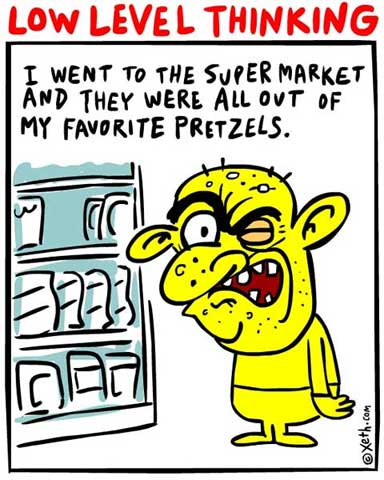
Low Level Thinking by Xeth
Visit: xeth.com and mishmashmedia.com
911 Was an Inside Job!
9-11 Cop Breaks Silence
By Dave Gahary, American Free Press, Article Source via prez @ usa-exile
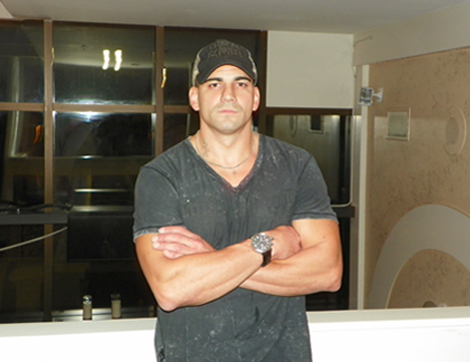
Scott DeCarlo
The New Jersey police officer responsible for capturing five Israelis who filmed and celebrated while the World Trade Center towers burned has broken his silence, agreeing to a Sept. 16 exclusive interview with AMERICAN FREE PRESS.
As AFP readers are no doubt aware, these are the same Israelis who were working under the direction of Urban Moving Systems, a Mossad front company at the center of Israeli involvement in the Sept. 11 attacks.
Sgt. Scott DeCarlo has never spoken to the media about the details of that day except for two 30-second cameo appearances in Internet videos from undetermined sources. In fact, DeCarlo confirmed that this is the first, and last, interview he will ever grant in regard to this subject.
DeCarlo revealed to AFP hidden details about the events of 9-11 that mainstream media venues should have uncovered 10 years ago, if not for their near-total blackout of meaningful coverage where Israel is concerned.
Although not scheduled to work that day, DeCarlo reported anyway and “was posted on the highway” to prevent traffic from entering New York City.
“There was a BOLO, which is a ‘Be On the Look Out’ for a particular van, perhaps loaded with explosives,” explained DeCarlo, “that may have been on its way to destroy the George Washington Bridge.”
DeCarlo explained: “It [the suspicious van] happened to come our way, and I grabbed my sergeant [DeCarlo himself was a patrolman at that time] and said: ‘Hey, man, that’s our van.’ It wasn’t the exact license plate given reported—it was off by one numeral—but I said: ‘That’s gotta be it; it’s just too close.’”
He continued: “The van was coming off the [N.J.] Turnpike trying to get on Route 3. Traffic was rolling at two miles an hour, so we got in front of the van on foot, weapons drawn, and stopped it.”
All five of the Israeli spies refused to exit their vehicle, so DeCarlo was forced to get physical.
“We asked them to get out of the van, but they didn’t listen,” he said. “So, we . . . put them in handcuffs and did it as quickly as possible.”
AFP asked DeCarlo why he thought the Israelis refused to follow his orders. DeCarlo was unsure, but asked this writer, “You ever have a gun pointed at your head?”
DeCarlo then described what happened after the spies were dragged from their van. “When we removed them, one of the guys that was rather chatty said: ‘We’re not your enemy, we’re your friend. Our enemies are your enemies,’” DeCarlo said. “At that point they said they were from Israel. They kept saying, ‘Hey, we’re on your side.’”
“We brought them over to the New Jersey State Police holding cells in the Meadowlands Stadium, and that’s the last I saw of them,” he said. Shortly after that, the FBI reportedly took over. The five Israelis were held for 10 weeks, but were eventually deported to Israel on charges of immigration violations. In November 2001, they appeared on an Israeli TV talk show discussing how they were in the U.S. “to document the event.”
Sgt. DeCarlo asked AFP to request interested parties not to contact him.
9/11 Was An Inside Job
Sometimes, Good S#it Happens
Thames Water turns to 'poo power' for renewable electricity generation
Company estimates that 16% of its electricity needs will be met in the current financial year by burning sewage flakes
Rebecca Smithers, consumer affairs correspondent, guardian.co.uk, Monday 26 September 2011 17.17 BST, Article history, Article Source

The sludge incinerator at the Crossness sewage works, south-east London, where the electricity will be generated. Photograph: Nic Hamilton/Alamy
They look like instant coffee granules, but they are in fact sewage flakes – a highly combustible new renewable form of fuel that burns like woodchip and is being used for the first time to generate electricity for Britain's largest water and sewerage company.
Thames Water has begun producing the flakes by drying sludge – the solids found in sewage – in a purpose-built machine at sewage works in Slough, Berkshire. In a not-so-green move, the company then takes the flakes by lorry to Crossness sewage works in Bexley, south-east London, where they are burnt off to generate electricity.
The company estimates that 16% of its electricity needs will be covered in the current financial year by so-called poo power – enough to run about 40,000 average family homes – from a total energy requirement of 1,300 gigawatt hours.
Until now, the sludge dryer had been used to reduce waste simply to get rid of it more conveniently. The dryer promises to reduce the firm's carbon emissions by more than 500 tonnes a year, as well as bringing up to £300,000 a year of operational cost benefits.
Rupert Kruger, Thames Water's head of innovation, said: "This is the first time in Britain that a waste dryer has been used to create ready-to-burn fuel from sewage sludge, rather than simply being used as a waste-reducer. This innovative approach demonstrates our clear intent to help move Britain towards becoming a low-carbon economy by unlocking every ounce of renewable energy potential from waste."
Five tonnes a day of sewage sludge – 20% of the solids left over from the treatment process at the Slough works – are being put through the new dryer, which works by heating the sludge to around 180C and driving off the water using enclosed heated rotating paddles. Because the sludge cake at Crossness is only about 25% dry, the process relies on non-renewable gas from the grid to keep the fire going in the sludge-powered generator.
A further 20 sewage works, including Slough, generate electricity by burning biomethane gas from sewage, a process know as combined heat and power.
Michael Moore tries to pull memoir from sale in 'murderous' Georgia
Film-maker asks for Here Comes Trouble to be withdrawn in protest over Troy Davis execution
Alison Flood, guardian.co.uk, Wednesday 28 September 2011 09.42 BST, Article history, Article Source
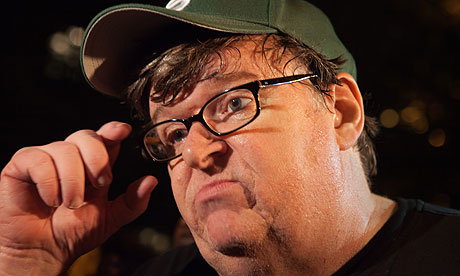
Michael Moore: 'I don't want a dime off of that state'. Photograph: Julie Dermansky/Corbis
Michael Moore has attempted to pull his new memoir Here Comes Trouble from every bookshop in the state of Georgia following the execution of Troy Davis last week.
The film-maker posted a statement on his website in which he said that he would ask his publisher to remove the book – published earlier this month – from shops in Georgia, "and if they won't do that I will donate every dime of every royalty my book makes in Georgia to help defeat the racists and killers who run that state".
Moore also called for a general boycott of the state. "I encourage everyone I know to never travel to Georgia, never buy anything made in Georgia, to never do business in Georgia," wrote Moore. "I ask all Americans with a conscience to shun anything and everything to do with the murderous state of Georgia."
Davis, who maintained his innocence over the shooting of a police officer in Savannah in 1989, was killed by lethal injection in Jackson, Georgia last Wednesday despite serious doubts about his guilt.
Georgian authorities seemed unmoved by Moore's threat, with a spokesman for governor Nathan Deal telling the Atlanta Journal-Constitution that "we think it's cute that he thinks anyone in Georgia would buy his book, but if any Georgian does, I'm happy to double the royalties and buy a pack of gum for a charity of Michael Moore's choice".
Moore later told Keith Olbermann's US television show that his American publisher Grand Central had not been able to pull the books from Georgia, so instead he is planning to donate money to criminal justice reform organisation the Innocence Project.
"I just got word before we came on the air. I asked my publisher this morning, 'I want you to stop shipping my book to Georgia. I want you to pull the books out of there. I don't want a dime being made. I don't want to make a dime off of that state until that state acts to change things.' And they just told me that they can't. They can't recall the books," he said. "So I am going to go to the next step then. I'm going to write a big cheque to the Innocence Project, who have gotten hundreds of people exonerated who were sitting in prisons. And since the Supreme Court reinstated the death penalty, well over 100 people who were on death row, who we were going to execute, we have then discovered they were falsely convicted, and they were set free. Well, they almost died - this Innocence Project is a great organisation."
Moore said he was also planning to fund voter drives in Georgia "to register our fellow Americans who are African-Americans, so that they have a chance to have their voice heard … there's 600,000 African-Americans in the last election that were not registered to vote".
"This has got to be stopped," he added. "We are a civilised nation, and yet we do not join the other civilised nations of this planet when we do things like this."
THRIVE: What On Earth Will It Take?
Flashback! Psychedelic research returns
Four decades after Timothy Leary, LSD shows success in medical trials. Will the right completely trip?
By Alexander Zaitchik, Wednesday, Sep 28, 2011 07:45 ET, Article Source

Diane Garcia via Shutterstock/iStockphoto: tempurasLightbulb
Kristof Kossut arrived at an unlikely address for his first psychedelic experience. The 60-year-old New Yorker and professional yachtsman opened the door not to an after-hours techno party, but to the bright reception room at the Bluestone Center for Clinical Research, a large spa-like space occupying the second floor of New York University's College of Dentistry. Kossut was among the first subjects of an NYU investigation into the question: Can the mystical states of mind occasioned by psychedelic drugs help alleviate anxiety and depression in people with terminal and recurrent cancer?
Kossut had no idea, but in the spring of last year, he was looking for something, anything, that might improve his mental state. In 2008, he was diagnosed with cancer of the tonsils and put on a biweekly chemo and radiation regimen. He quickly lost his appetite, dropped weight and sank into a deep depression. When a friend sent him a news brief about the experimental NYU study, he applied.
Shortly before Kossut's arrival on the morning of his session, two clinic employees entered a high-security storage room, which just happens to face a painting of a white rabbit. From a massive steel combination safe they removed a bottle containing one gram of synthesized psilocybin, the psychoactive agent animating the 200-member fungus family commonly known as "magic mushrooms." The duo carefully measured the small container against the previous day's weight, as if securing a store of weapons-grade plutonium. They then pill-pressed an amount of powder containing 20 milligrams of the molecule, first identified in 1958 by the Swiss chemist Albert Hoffman, most famous for his other psychedelic synthesis, LSD-25.
They delivered the pill to a converted exam room gutted of its dental chair and refitted for comfort with holistic panache: plush pillow-strewn sofa, Persian carpet, Buddha statuettes, books on spirituality and mysticism, a high-performance sound system. Only the ceiling lighting track betrays the former identity of New York City's federally sanctioned psilocybin room.
Receiving the pill is Dr. Stephen Ross, a 40-year-old assistant professor of psychiatry at NYU Medical School and the cancer study's principal investigator. Ross has a precise scientific manner softened by an upbringing in Southern California, where his mother (also a doctor) took him to hospice centers as a child, sparking an interest in end-of-life issues. Now director of the addiction division at Bellevue, Ross is among the youngest of a new generation of psychedelic researchers. With his cancer study still two years away from publishing results, he is already looking ahead to testing psychedelic treatments for drug addiction and alcoholism.
For now, Ross is fully focused on treating existential anxiety in people like Kossut, who lies on the couch, ready for his initiation into the psychedelic mysteries. In the research jargon, Kossut is "psychedelic naive." After swallowing the pill Ross presents -- in the cap of a ceremonial ceramic mushroom -- all he can do is close his eyes, lose himself in the preselected tabla drum and sitar music, and try to remember the advice to not fight it, to move ever deeper into the light, to let go ...
"It was absolutely incredible," remembers Kossut. "The first rush was a little scary as I realized it wasn't the placebo. That passed and next I was crossing boundaries of time and space and reality. I felt this weightlessness, this sense of being close to an unspeakable beauty that was unlike anything in my experience. For the first time since my diagnosis, I was not afraid of anything. The wall of depression that was building up day by day, the fear that I was going to die soon, that my daughter is only 8 -- all those things disappeared. I wanted to stay there. I wanted it to last longer."
It did. More than one year after his psilocybin session, Kossut reports greatly improved states of emotional and psychological well-being. "I walked out of the session happy, unafraid of death," he says. "I don't know why, but a transformation took place after being in that peaceful place. I relaxed. I started enjoying food again and was able to gain weight. The session taught me to be fully in the present. I'm optimistic. Mentally and physically, just better."
This glowing report -- based on a single dose of a naturally occurring, non-addictive, low-toxicity substance -- sounds impossible. Surely one pill can't succeed where months of traditional psychotherapy and antidepressants usually fail. According to science, that's not how drugs work. It's foreign to the model. But high success rates in ongoing concurrent studies at NYU and Johns Hopkins strongly suggest that Kossut's psilocybin-assisted psychological rebound is no fluke. So do the findings of a pilot project conducted by Dr. Charles Grob at UCLA. Between 2004 and 2008, Grob administered psilocybin to 12 cancer patients suffering fear, anxiety and depression. His data, published last year in the Archives of General Psychiatry, showed long-term diminished anxiety and improved mood in every subject. The NYU and Johns Hopkins studies build on Grob's pilot program with more subjects and higher doses. Midway through the research, their results are just as strong, signaling larger, multi-site trials to come.
"What appears to be going on with the psilocybin studies is a model system for creating 'quantum change,'" says Dr. Roland Griffiths, the behavioral biologist who oversees the Johns Hopkins study. "We've shown we can safely produce replicable effects."
This is the subdued, clinical language of a psychedelic science renaissance quietly entering its third decade. If its practitioners and advocates avoid the utopian claims and liberationist rhetoric that defined the LSD gospel of the 1960s, this is no accident. A new generation of psychedelic researchers understands that public and official support depends on exorcising the ghost of Timothy Leary, whose democratic acid crusade grew out of and ultimately helped destroy the first wave of psychedelic science in the 1950s and '60s. Their goal is not to promote the legalization of these drugs or tout their value for everyone, but to revive the once-great and now largely forgotten promise of psychedelic science. And that just might, among other things, change the way we confront and think about death.
- - - - - - - - - -
Dosing anxious cancer patients with psychedelics may sound counterintuitive, to put it mildly. The hallmarks of the psychedelic experience -- the loss of bearings in time and space, the breaking up and slipping away of the sense of self -- can themselves produce acute anxiety and panic. Everyone has heard stories, most of them apocryphal, of psychedelic experiments gone wrong; of kids on acid jumping off of 12-story buildings, or showing up in emergency rooms a twitching, psychotic mess, requiring enough Thorazine to sedate a horse.
But the current studies are not self-experiments. They are carefully designed and professionally guided therapy sessions crafted to minimize anxiety and avoid so-called bad trips. Subjects are screened and prepared before ingesting the psilocybin in a plush environment overseen by two specially trained therapists. Even the dose employed is the result of trial and error: The Johns Hopkins team has identified the golden mean -- between 20 and 30 milligrams, roughly equal to a good fistful of strong 'shrooms -- to maximize peak experience while minimizing transitory anxiety.
Which is not to say that subjects don't sometimes get scared. Clark Martin, a retired psychologist who suffers recurrent kidney cancer, panicked during the onset of his first psilocybin session at Johns Hopkins. "Initially it was like falling off a sailboat," he remembers. "You turn around, the boat is gone. Then the water's gone. Then you're gone. I wanted things to make sense again. My urge was to run outside."
But his guides calmed him and the anxiety passed. Today what Martin remembers best is what came next.
"Everything became tranquil and calm, and I had the sense that I was floating on a giant bubble," says Martin, who spent the next several hours in this peaceful place meditating on life, death, the nature of human relationships and consciousness. "I left the session animated and intellectually stimulated. Today I don't have a sense of death like I used to. I see it as part of the flow of nature. There's grieving and sadness, of course, but what's being lost is this false sense of separateness we create. I don't get too worked up about my illness anymore. My relationship with my daughter is better. I'm also more fully present and empathic when I spend time with my elderly father, who has dementia."
What's going on here? How does psilocybin induce states of consciousness capable of dramatically reorienting one's mental frame? The beginnings of an answer may be found in the morning mists of recorded history. In the ancient world, disparate cultures from the Amazon to Siberia consumed psychedelic mushrooms and plants in sacred rituals they viewed as openings into spirit worlds where mysteries were revealed and ineffable wisdom communicated. Often these rituals were conducted by "medicine men" and focused on themes of disease, death and healing, as in the case of Amazonian cultures where doctors still engage in ritualized use of the "healing plant" Ayahuasca.
No one is claiming that psychedelics cure disease. But around the time Western science discovered psychedelics in the 1890s, psychology of religion scholars began to notice a recurring cross-cultural motif -- the psychic salving power of what American psychiatrist Richard Maurice Bucke called "cosmic consciousness." To research his landmark 1902 study "Varieties of Religious Experience," the psychologist and philosopher William James surveyed a vast global record of spiritual literature. Again and again, he encountered reports of death anxiety evaporating upon the direct experience of mystical states of consciousness. The reports of Kristof Kossut and Clark Martin overlay neatly with James' description of the afterglow provided by mystical consciousness, "of which the central [characteristic] is the loss of all the worry, the sense that all is ultimately well with one, the peace, the harmony, the willingness to be, even though our outer conditions should remain the same." Throughout history and in every culture, James found, those who experience "the full flood of ecstatic liberation" tend to benefit afterward from "a new zest which adds itself like a gift to life ... and a temper of peace."
This insight led James to advocate for experimental mysticism, which helped him treat his own bouts with severe depression. In the 1870s, James began using nitrous oxide (a hallucinogen that shares characteristics with ketamine and PCP) as a shortcut to the experiences cataloged in "Varieties." He found the practice salutary. Mind-blowingly so. But nitrous is just laughing gas compared to the classical hallucinogens that concerned James' heir in the annals of chemical mystics.
In the middle of the otherwise staid 1950s, the writer Aldous Huxley emerged as a muscular advocate for psychedelics. His conversion followed his first mescaline trip, immortalized in the slim but influential 1954 work "The Doors of Perception." Like James, Huxley's experiments built on a lifelong interest in mystical states. His cross-cultural examination of mystical testimony, "The Perennial Philosophy," found the same aspects to the experience as recorded in today's psilocybin studies: a sense of access to ineffable and intuitive knowledge; a sense of unity, transcendence and sacredness; overwhelming, ecstatic positivity felt as joy, love and peace.
Timothy Leary was the first scientist to test the power of psychedelics to trigger these states. In 1963, his last year at Harvard, Leary supervised an experiment in which psilocybin was administered to 10 seminary students attending the Good Friday sermon at Boston University's St. Marsh Chapel. Of the 10, eight claimed to experience something like mystical consciousness. Forty years later, Roland Griffiths updated the Marsh Chapel experiment at Johns Hopkins by administering psilocybin to healthy individuals with an interest in spiritual states. As he reported in the journal Psychopharmacology, nearly 80 percent of subjects listed their psilocybin session as among the top-five most meaningful experiences of their lives, and described the experience in language straight out of the mystical literature. Follow-up monitoring by the subjects' families and friends found sustained positive changes in personality, behavior and mood.
The fact that psychedelics act as shortcuts to mystical states provides only one-half of the logic underlying the psilocybin-cancer studies. The young field of palliative care provides the other half with its research into "good deaths." The palliative-care literature finds that those with a sense of a transcendental force have less depression and anxiety. This can mean belief in a Judeo-Christian god, or a direct memory of the nameless, overwhelming sense of eternal, cosmic love occasioned by the ingestion of 20 or 30 milligrams of psilocybin.
"Psychedelics are a powerful mechanism for forging a connection to a transcendental force, and people with such a connection are protected against end-of-life distress," says NYU's Ross. "We all have cognitive illusions that protect us from the knowledge that we will die, and medicine is failing those who have to deal with this abruptly."
Psilocybin metabolizes quickly, and follow-up doses are not needed to maintain long-term effects. This means that the psilocybin studies are not really drug studies in the traditional sense. They are more like experiential studies, in which the benefit is derived from the memory of something that isn't easily explained away by reference to serotonin receptors. "Eternity, a state of awareness outside of time, often described as pulsating with love and life, no longer is an abstract concept," explains Bill Richards, a therapist with the Johns Hopkins team who has been working with psilocybin since 1963. "Rather [it] is a memory of an experience, perhaps more vivid than the memory of visiting a foreign city on a vacation. Typically fear becomes replaced with curiosity and trust in deeper strata of consciousness."
Among those who have benefited from a new trust in these deeper strata of consciousness is Janeen Delany, a Phoenix woman who flew to Baltimore for psilocybin therapy in 2008 after a leukemia diagnosis.
"I was struggling emotionally with my fear," she remembers. "No matter how hard I tried to do the work myself, I couldn't get to that place of acceptance." More than two years later, Delaney describes her psilocybin experience as the turning point in coming to terms with her illness. "It changed my frame of mind," she says. "This disease no longer defines me when I wake up in the morning. I understand myself as part of a greater whole made up of energy and frequencies. It's impossible to put these insights into words, but they were real; are real. It felt like a thousand pounds lifted off my shoulders. I'm now the person I always wanted to be."
- - - - - - - - - -
Using psychedelics to treat terminal anxiety was popularized in the West in Aldous Huxley's 1962 utopian novel "Island," in which the natives of the fictional paradise Pala ingest a psilocybin-like drug called moksha during stages-of-life rituals, including infirmity, sickness and death. Huxley himself would famously request and receive a large intravenous dose of LSD on his own deathbed the following year.
Shortly after Huxley's passing, Eric Kast of the Chicago Medical School began a four-year study administering LSD to cancer patients in extreme pain. He discovered that along with reorienting the patient's relationship to death, the psychedelic had an analgesic effect resulting from an "attenuation of anticipation." Following their LSD treatments, Kast wrote, subjects developed "a peculiar disregard for the gravity of their situations and talked freely about their impending death with an affect considered inappropriate in our Western civilization but most beneficial to their psychic states."
A former graduate student of Tim Leary's named Walter Pahnke picked up Kast's work in 1968 at Spring Grove Hospital in Baltimore. As part of a psychedelic dream team including Stanislav Grof and Bill Richards, Pahnke successfully administered LSD and psilocybin to more than 100 cancer patients between 1968 and 1977. The National Institute of Mental Health funded much of their work.
The cancer anxiety studies of the ‘60s and ‘70s were part of a global postwar flowering of psychedelic science. Researchers published hundreds of peer-reviewed papers, with LSD receiving the bulk of the attention. Psychedelic drugs were considered a revolutionary tool, frequently compared to the invention of the telescope or microscope. They were seen as keys to understanding and finding treatments for everything from alcoholism to autism to schizophrenia. This was not a fringe view, but that of respected researchers backed by the Food and Drug Administration and funded by institutions like the Rockefeller Foundation. There were research grants galore and conferences sponsored by the American Psychiatric Association. (We'd later learn that the CIA funded many psychedelic research projects. But that's another article.)
The golden age of psychedelic studies proved brief. Even before recreational use exploded in the mid-1960s, the government had begun moving toward the view of the military and intelligence establishments that psychedelics were mere "psychotomimetics" (i.e., they mimicked psychosis) holding no scientific use (let alone spiritual or humanistic value). A series of laws throughout the decade steadily restricted and discouraged scientific access to psychedelics culminating in the 1970 Controlled Substances Act, which grouped psychedelics together with heroin as a Schedule 1 drug. According to the Drug Enforcement Agency, created in 1972, Schedule 1 drugs "have a high potential for abuse [and] have no currently accepted medical use in treatment in the United States."
The closing of the psychedelic mind involved the weaving of a fine-spun stigma and the application of indistinct professional pressure. "A subtle microphysics of power guided scientists away from further work on these compounds," says Nicolas Langlitz, an anthropologist at the New School who studies psychedelic science. "The allocation of funding, having to guard one's reputation, approval of research projects, recruitment of test subjects -- it all led to a near-total breakdown of academic hallucinogen research." Before the end of the '60s, two leading lights in the field would bemoan the fact that interested and capable scientists were "turning their backs on psychedelics for fear of identification with irresponsible researchers."
Then as now, "irresponsible researchers" was synonymous with Timothy Leary, the ex-Harvard professor turned self-styled laughing leprechaun and high priest of an everybody-must-get-stoned psychedelic revolution. Among the new generation, resentment of Leary's legacy remains palpable, as is the determination to avoid the mistakes, indeed the tragedy, of the 1960s.
"Leary so undermined credible scientific use of these compounds that it poisoned research for decades," says Griffiths of Johns Hopkins. "The iconic scientist goes AWOL and promotes unrestricted recreational use. As a result, I don't know of any other set of scientific questions that have been banned for decades because it was judged too dangerous to study. Maybe germ or chemical warfare. But I doubt those were actually stopped."
Bill Richards, the avuncular Hopkins therapist who knew Leary and has overseen thousands of psychedelic sessions over 50 years, has learned to take the long view. "One of our sayings during the sessions is 'Let go,' which we needed to do," he says. "The old fires needed to die down. Leary's ashes needed to get launched into outer space. Now I'm hopeful. The research proceeds with integrity."
- - - - - - - - - -
This quickening psychedelic revival was a long time coming. Activists and scientists began laying the groundwork during the second Reagan administration, when their efforts seemed most futile. In 1986, Rick Doblin founded the Multidisciplinary Association of Psychedelic Studies to advocate and educate the public. Not much happened until 1990, when Rick Strassman of the University of New Mexico Medical School broke ground with a study on the affects of DMT, the so-called nuclear bomb of the psychedelic family. Then, early in the first Clinton administration, the National Institute of Drug Abuse and the Food and Drug Administration quietly signaled a readiness to approve new psychedelic research. Encouraged by the signs, a group of scientists founded the Heffter Research Institute in 1993 to fund projects and hold them to the highest scientific standards.
The early naughts witnessed a further eroding of the psychedelic research taboo. The big foundations and government agencies maintained their distance, but groups like MAPS, Heffter and the Council on Spiritual Practices stepped in to underwrite medical school studies involving Schedule 1 drugs such as Ketamine, MDMA, marijuana and psilocybin. Mid-decade, Harvard's John Halpren finally exorcised Tim Leary's Cambridge ghost when he won approval for a small cancer anxiety study employing MDMA. The data from these and other studies is now beginning to appear in medical journals and on professional association conference agendas. This year, a chapter on psilocybin therapy for cancer patients will appear for the first time in a standard psycho-oncology textbook.
Much of this activity is centered at NYU, where a vibrant community of therapists and scientists has emerged around an ongoing speaker's series called the Psychedelic Research Group. In 2008, Dr. Jeffrey Guss, a Manhattan therapist and co-investigator on the NYU study, taught "Psychedelics and Psychiatry," the first course on psychedelic therapy offered at a modern medical school. Guss also directs the university's 12-week psychedelic psychotherapy training program, the only program of its kind in the country. "We're establishing a conversation across disciplines -- oncology, psychiatry, palliative care -- to reintroduce psychedelics into the medical discourse," says Guss. "The field is emerging as a doable career, and I've started to mentor people who want to move exclusively in this direction."
For political and scientific reasons, cancer anxiety is the research avenue with the most potential to scale up in the near future. Advocates like MAPS' Doblin optimistically envision a scenario in which the therapy could be more widely available in a decade. Getting there will require larger trials and a full rescheduling review by the DEA and the Department of Health and Human Services. "Getting a drug rescheduled is very difficult," says Bill Piper, national director of the Drug Policy Alliance. "But by its charter, the DEA is bound to follow the science."
Establishing psilocybin-assisted therapy as an accepted option for end-of-life care could have some surprising consequences. Among them is a fundamental reorienting of our culture's relationship to death. It could move discussion on what constitutes a “good death” and how to better provide them. Because Western medicine focuses narrowly on defeating disease with little consideration for how we die, the sick often spend their last weeks and days surrounded by machinery and hospital staff instead of a comfortable hospice setting surrounded by family.
"There is an increasing understanding that there is a paucity of approaches to psycho-spiritual well-being at end of life," says Anthony Bossis, a palliative-care expert at NYU and co-investigator of the psilocybin study. "Medicine doesn't talk about how we die. Palliative care brought psycho-spiritual stress into the conversation, and now psychedelic research is enlarging that conversation by exploring the ontological shifts, like that brought about by psilocybin, which can affect one's outlook on life, death, disease."
Adds Griffiths of Johns Hopkins: "So much money gets poured into those last few months of life where people are terrified and grasping at anything to prolong life. It's heartbreaking to see, but our culture has such a disordered relationship to end-of-life issues. Change that, and people will change their utilization of the medical system. They'll use it more in some ways, less in others. The result would be a huge net decrease in expensive interventional procedures in the final weeks."
If and when psilocybin enters the larger healthcare debate, it will trigger the mother and possibly deciding battle of the 1960s culture wars. The prospect of Medicare dollars going to psychedelic therapy would send right-wing opportunists into a stomping rage. Sarah Palin would tweet about Hippie Death Panels. The GOP might revive its 1972 battle cry about liberals marching under a banner of "acid, amnesty and abortion."
But here the history of the medical marijuana movement is instructive. Drug warriors could only deny the medicinal value of marijuana for so long; soon they were forced to beat a retreat before the combined forces of the medical literature, lobbying and advocacy, and the reality of millions of suffering Americans. If the science is solid, it usually wins, if only in fits and starts. This is especially true when the science is accompanied by the moving testimonies of people like Roy, a 52-year-old television news producer and Stage-4 lung-cancer patient who this summer underwent psilocybin treatment at NYU after three years of chemotherapy. Like Krystof Kossut and dozens of others, Roy had grown increasingly anxious and depressed before his revelatory psilocybin session. Today he describes that session as among the most precious and important experiences of his life. His journal is excerpted in a forthcoming chapter in Springer's textbook, "Psychological Aspects of Cancer," co-authored by Bossis and Guss of the NYU study and Charles Grob of UCLA.
"From here on love was the only consideration," Roy writes of his psilocybin session.
Love seemed to emanate from a single point of light. The bliss was indescribable ... I took a tour of my lungs. There were nodules but they seemed rather unimportant ... I was being told (without words) to not worry about the cancer ... it's minor in the scheme of things, simply an imperfection of your humanity and that the real work to be done is before you. Again, love ... [On the day after the session] I felt spectacular ... both physically and mentally! It had been a very long time since I'd felt that good ... a serene sense of balance ... Undoubtedly, my life has changed in ways I may never fully comprehend. I now have an understanding, an awareness that goes beyond intellect, that my life, that every life, and all that is the universe, equals one thing: Love.
It's true we don't know much about psychedelic states of consciousness. Are they merely biochemical carnivals producing internal hallucinations, or are they -- as people often describe them -- "more real than real"? The psychedelic experience has always been just that -- the ultimate subjective experience, ineffable and very difficult to account for when over. But those who doubt its power or "reality" might remember that we also have precious little understanding of the neurological basis of "normal" consciousness. And when it comes to bringing comfort to the ill, of giving the gift of "indescribable bliss," a case can be made for the irrelevance of ultimate metaphysical and scientific questions. The first psychologist to advocate for experimental mysticism also advocated for that most American of thought systems, pragmatism.
Truth, concluded William James, is what works. - [Why Not Try Love Again? by Jumpin' Jupiter (MP3)]
Freedom of expression and freedom of speech aren't really important unless they're heard...It's hard for me to stay silent when I keep hearing that peace is only attainable through war. And there's nothing more scary than watching ignorance in action. So I dedicated this Emmy to all the people who feel compelled to speak out and not afraid to speak to power and won't shut up and refuse to be silenced. - Tommy Smothers
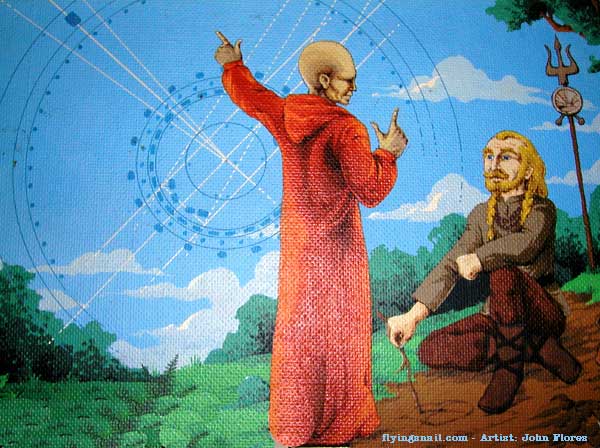
The man whispered, "God, speak to me" and a meadowlark sang. But the man did not hear. So the man yelled "God, speak to me" and the thunder rolled across the sky. But the man did not listen. The man looked around and said, "God let me see you" and a star shined brightly. But the man did not notice. And the man shouted, "God show me a miracle" and a life was born. But the man did not know. So the man cried out in despair, "Touch me God, and let me know you are there" Whereupon God reached down and touched the man. But the man brushed the butterfly away and walked on.

Don't miss out on a blessing because it isn't packaged the way you expect.


